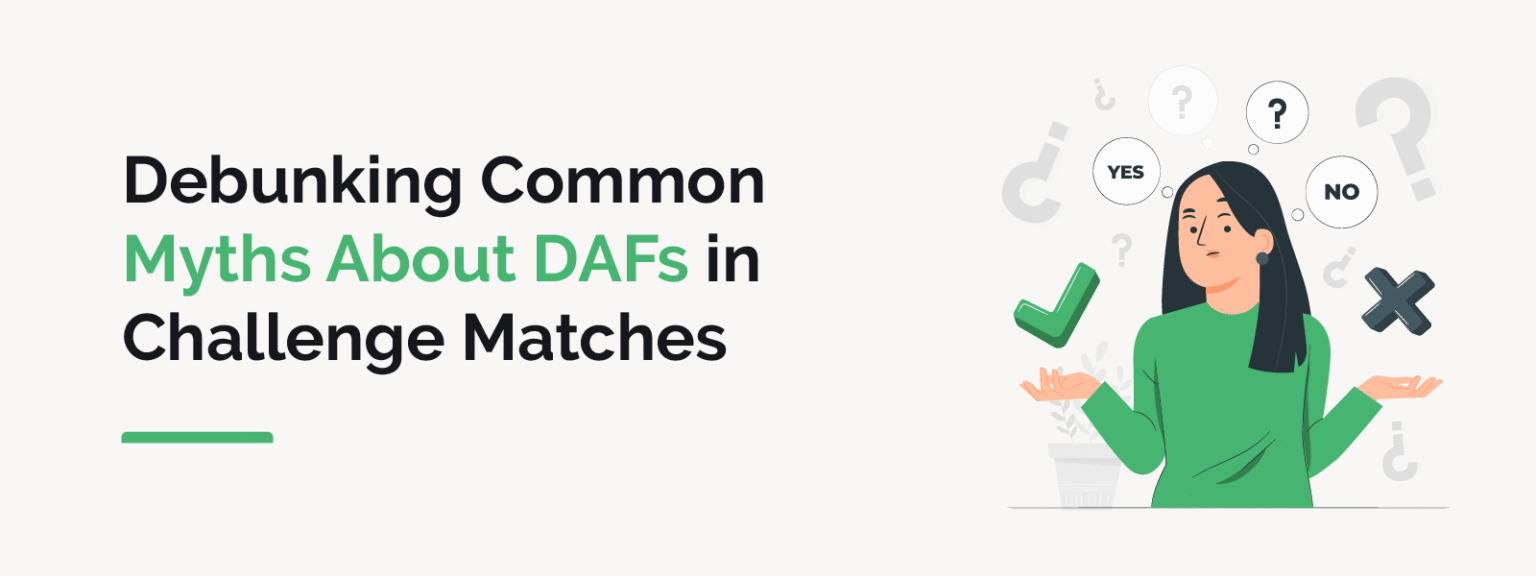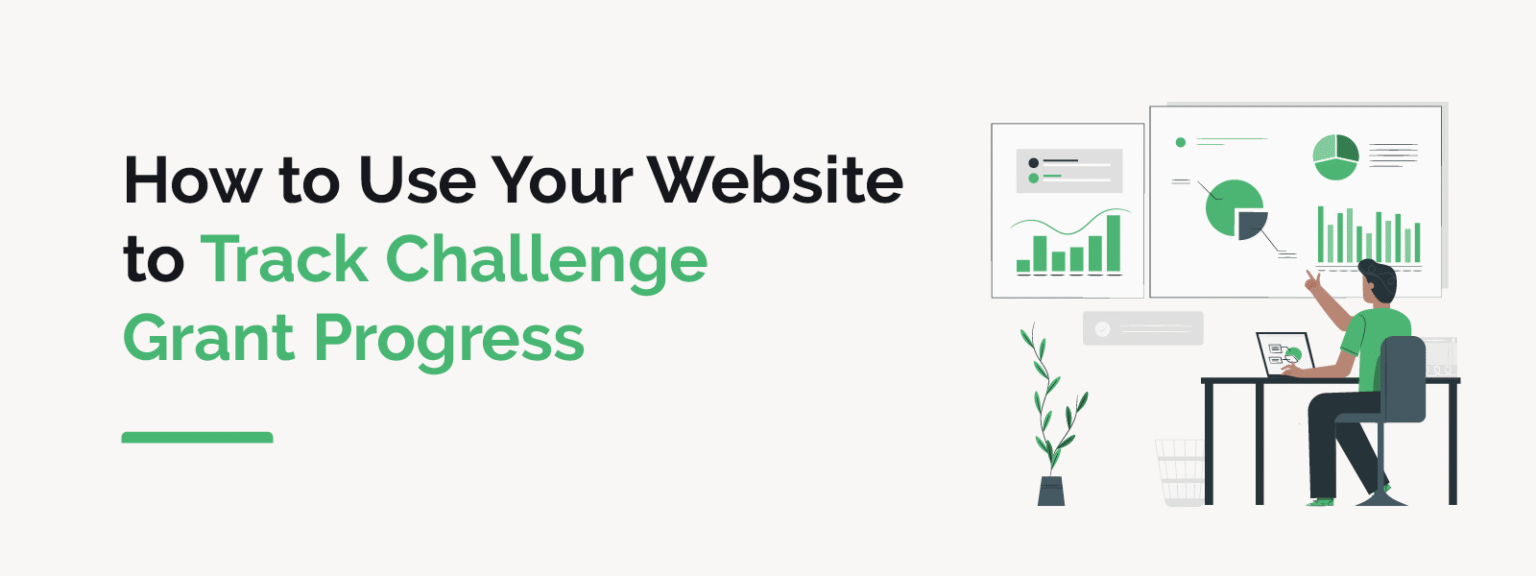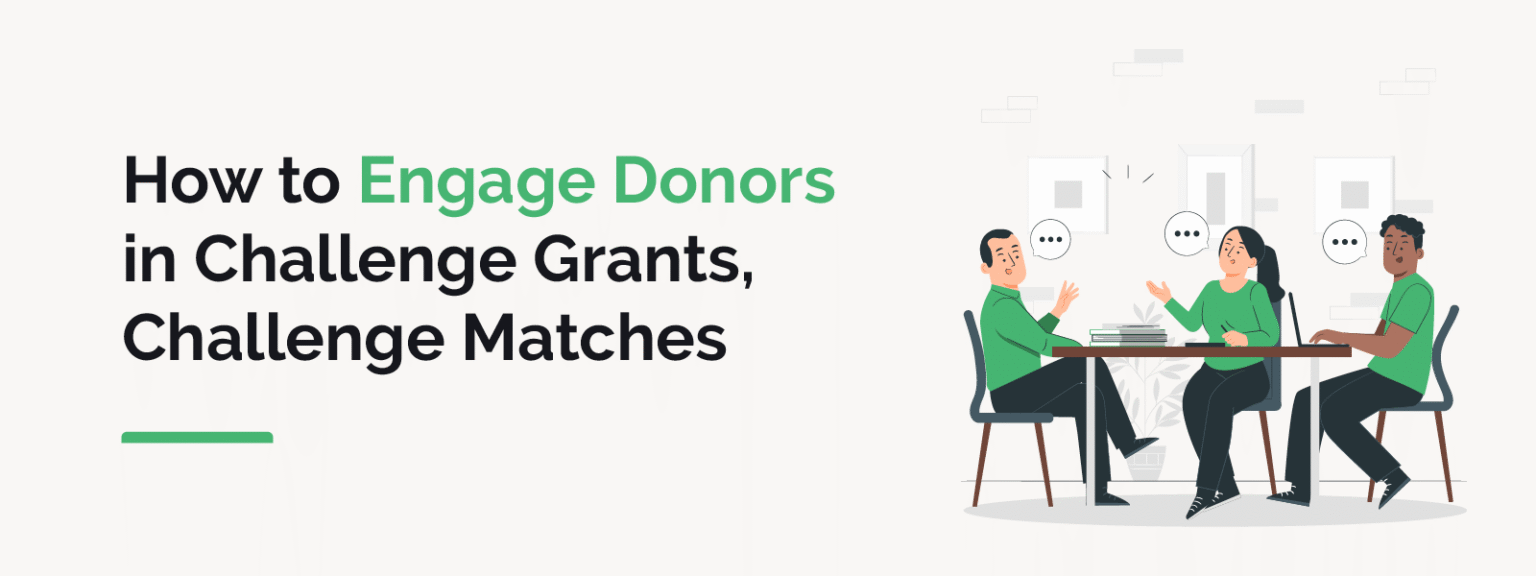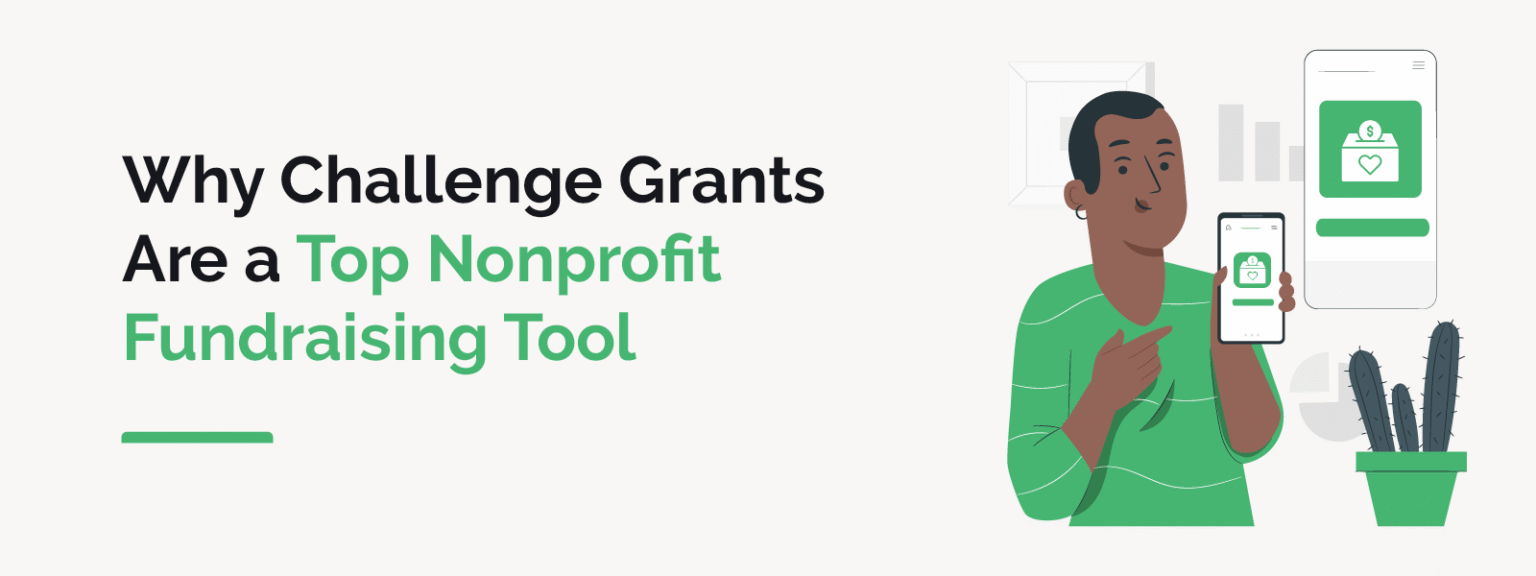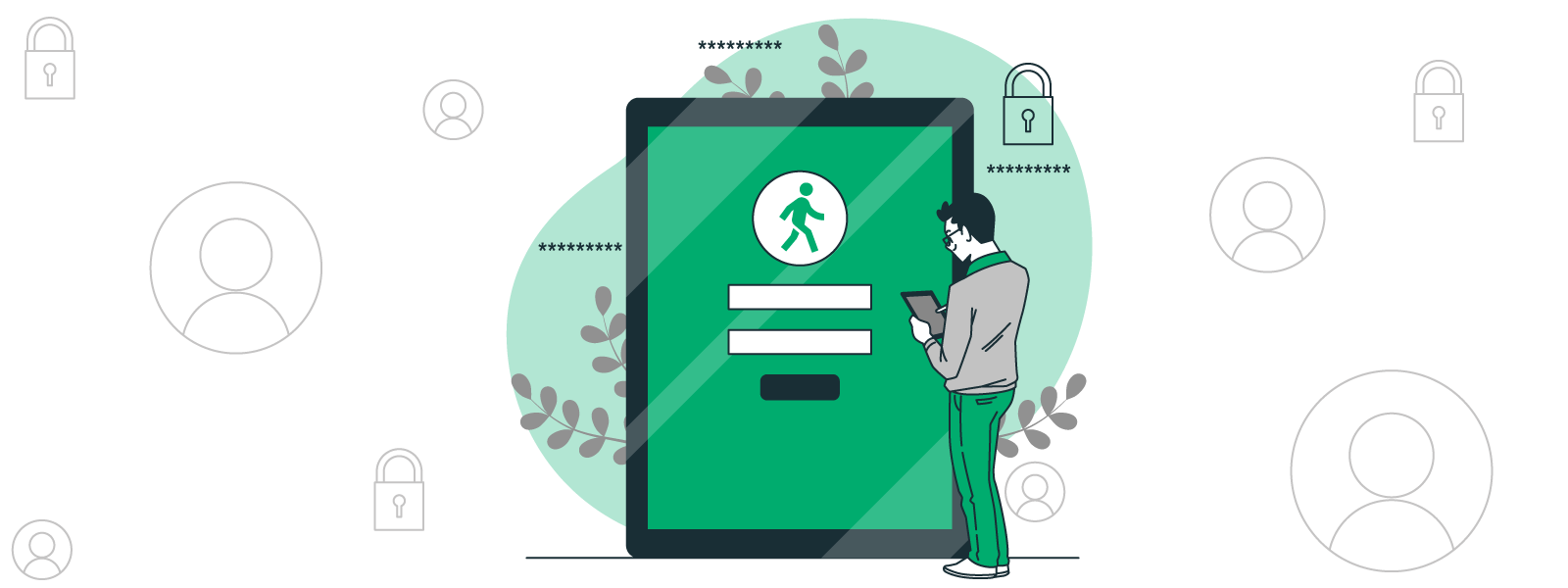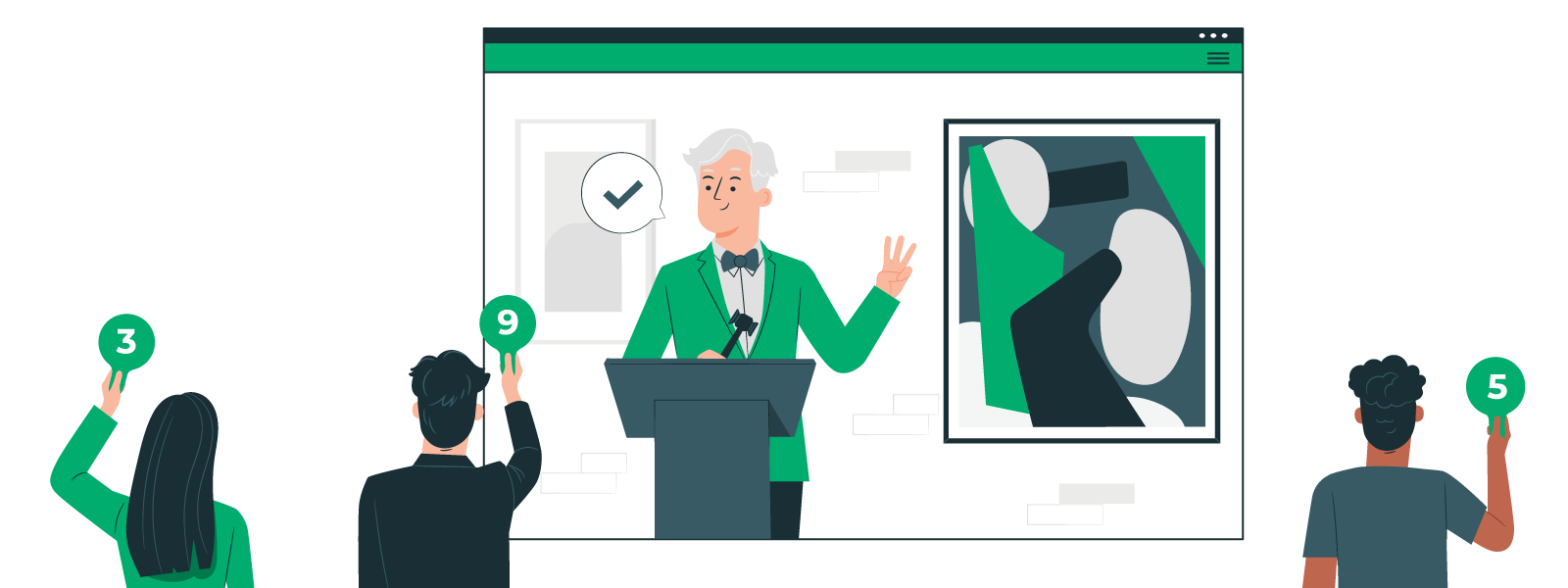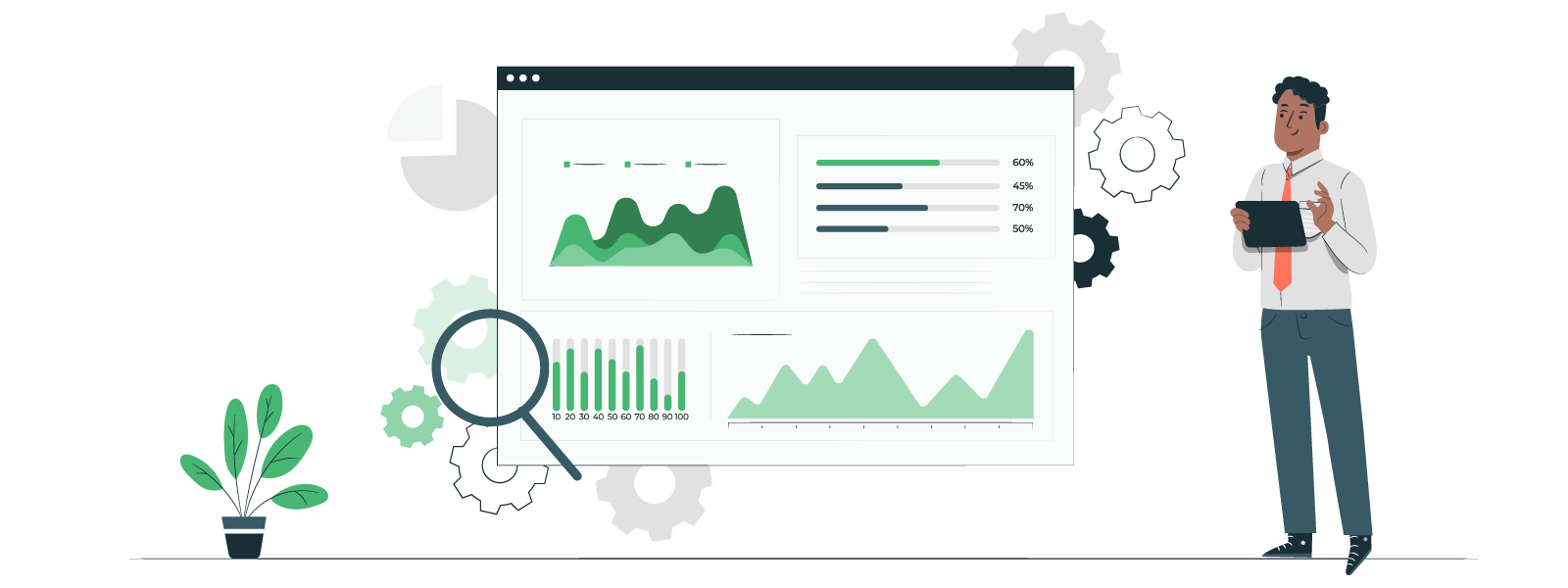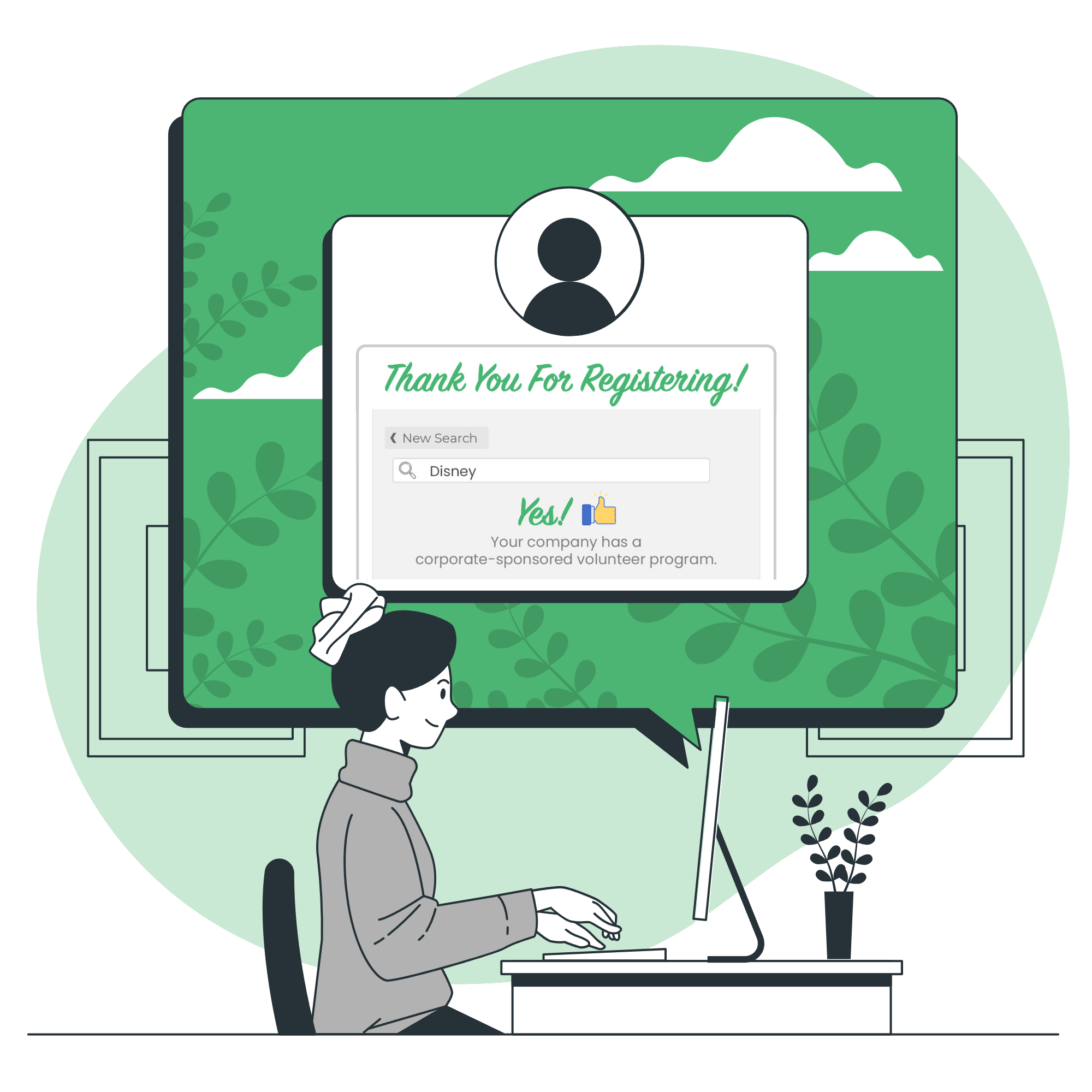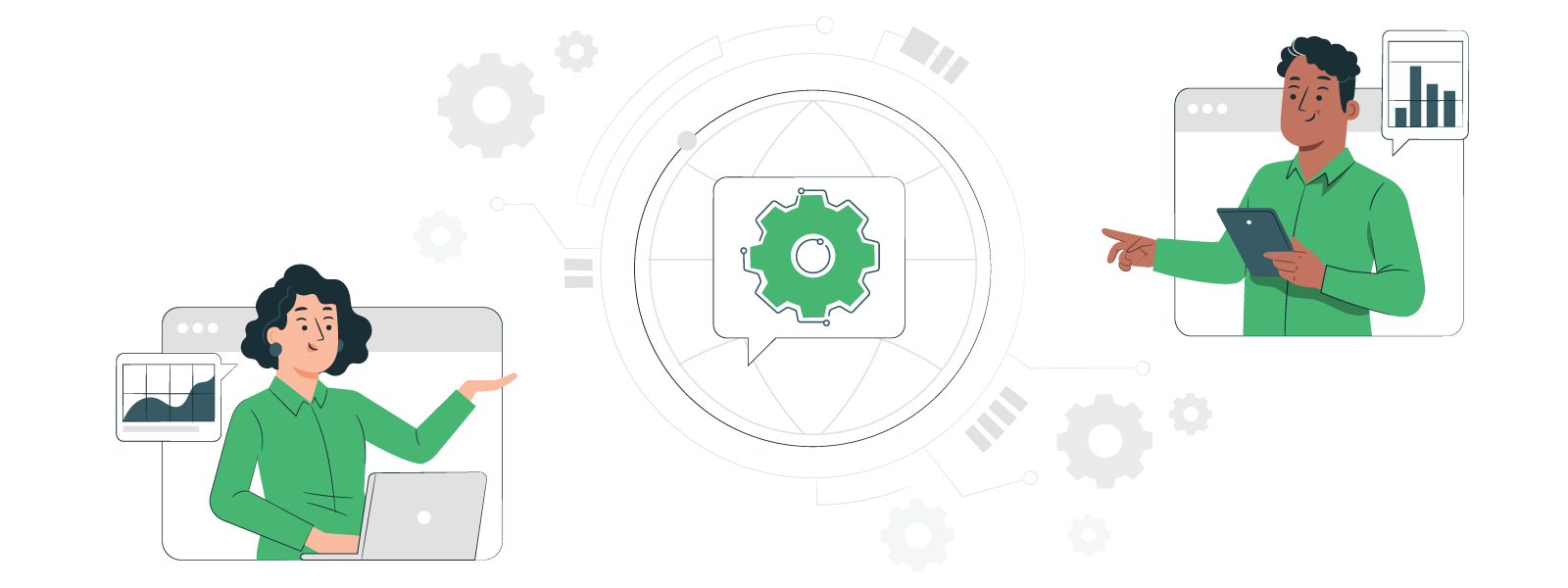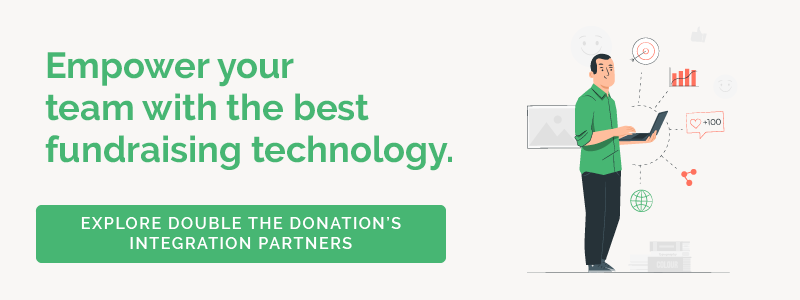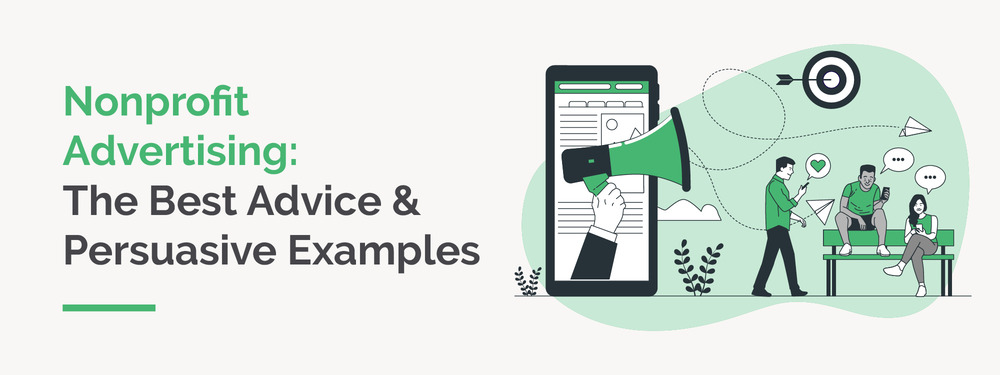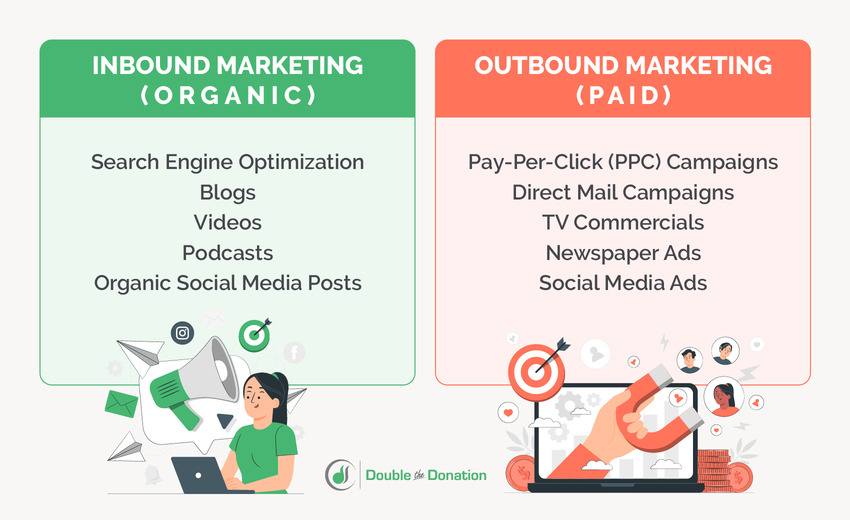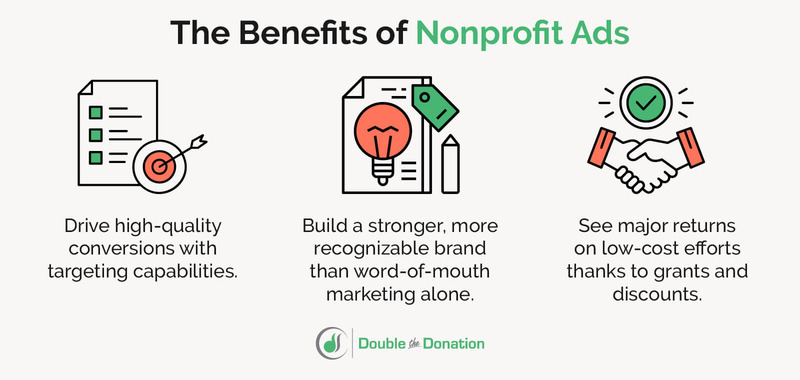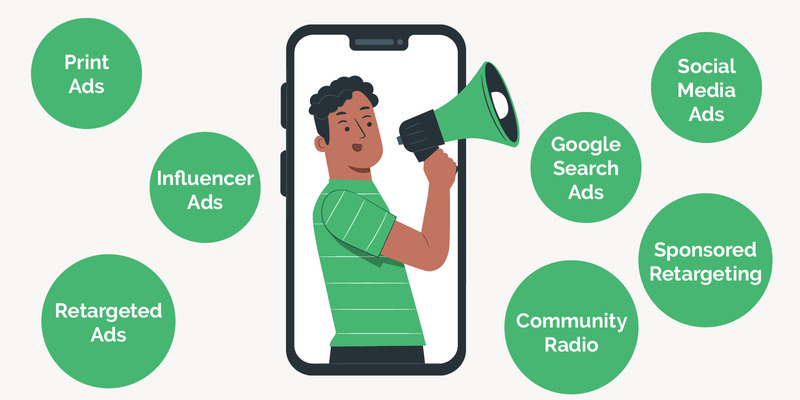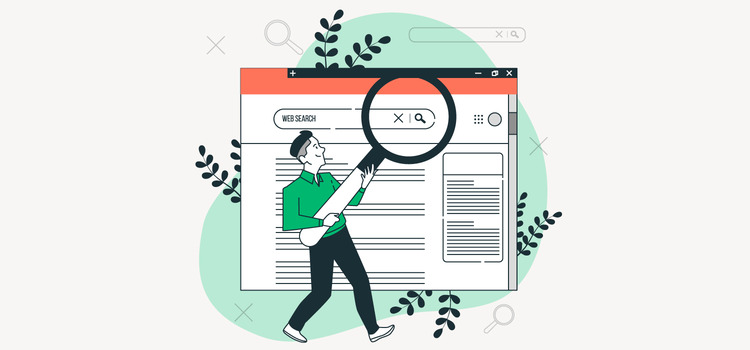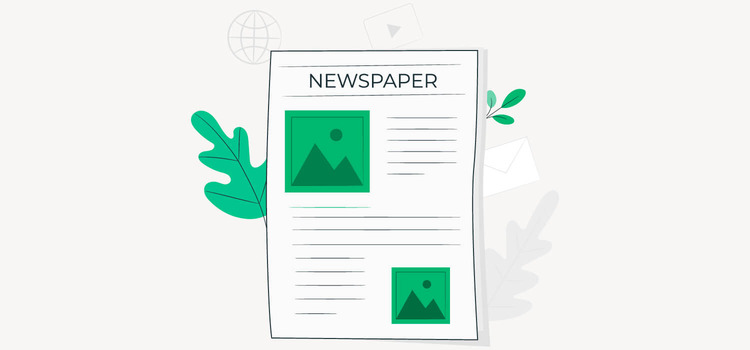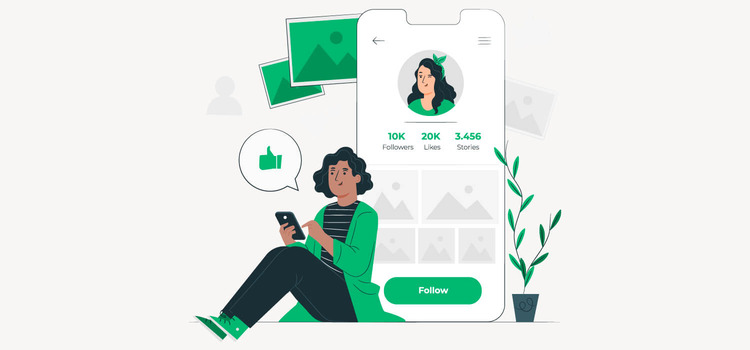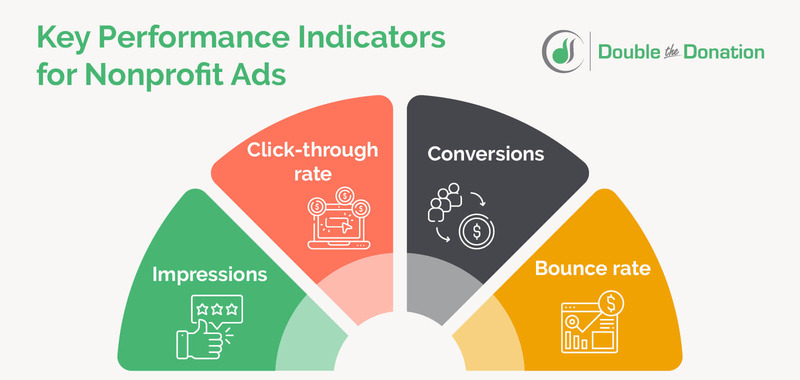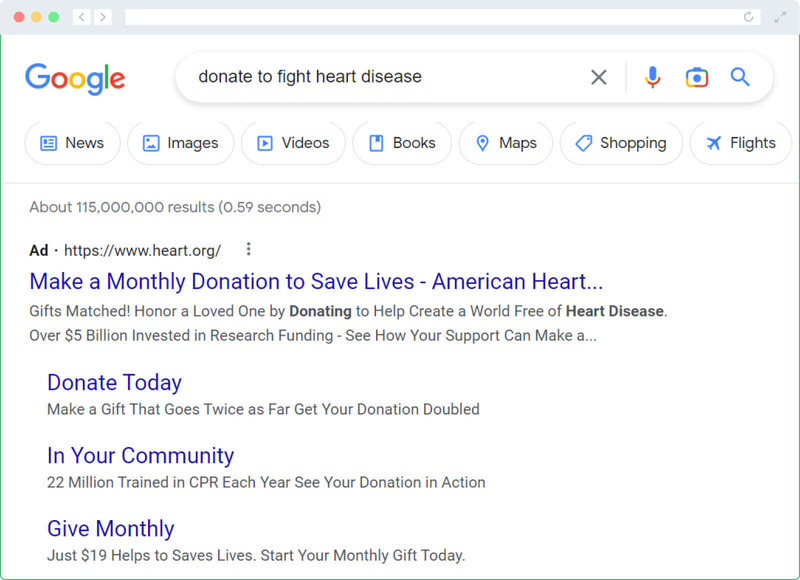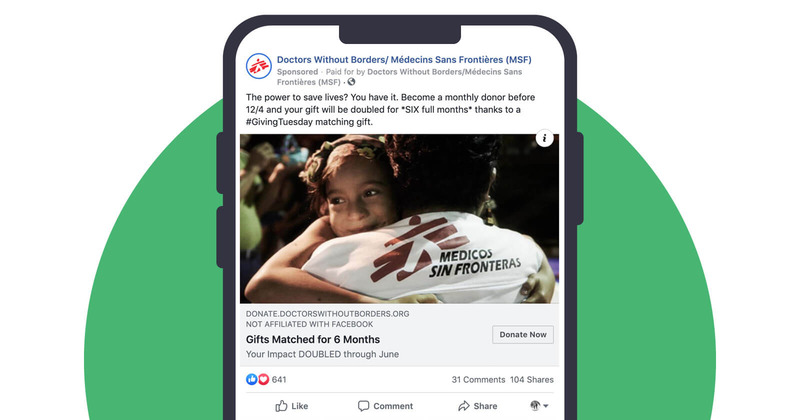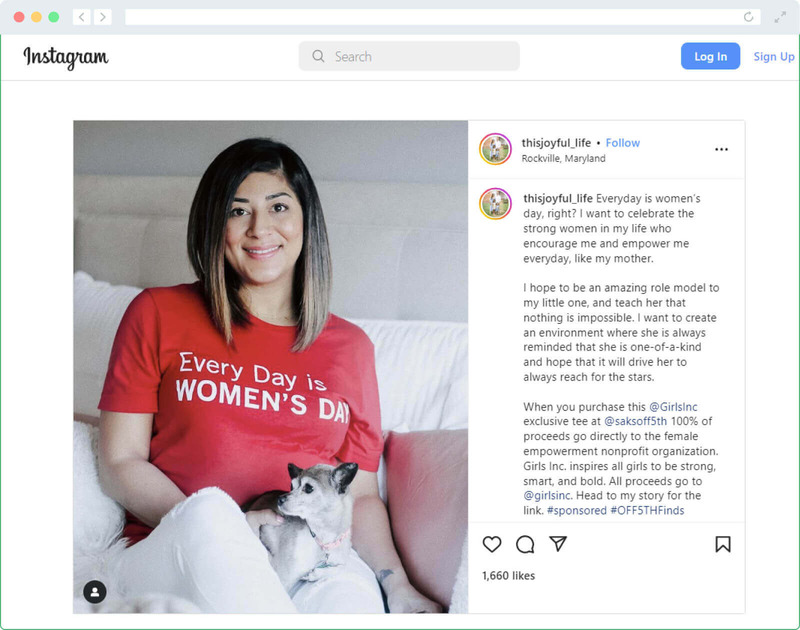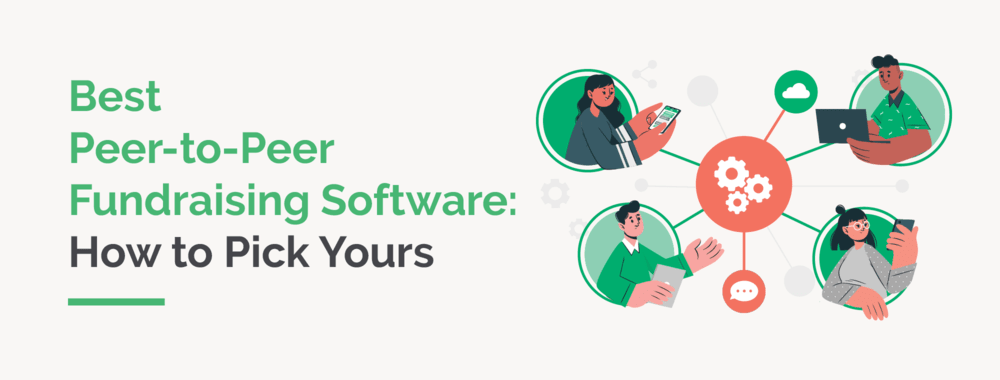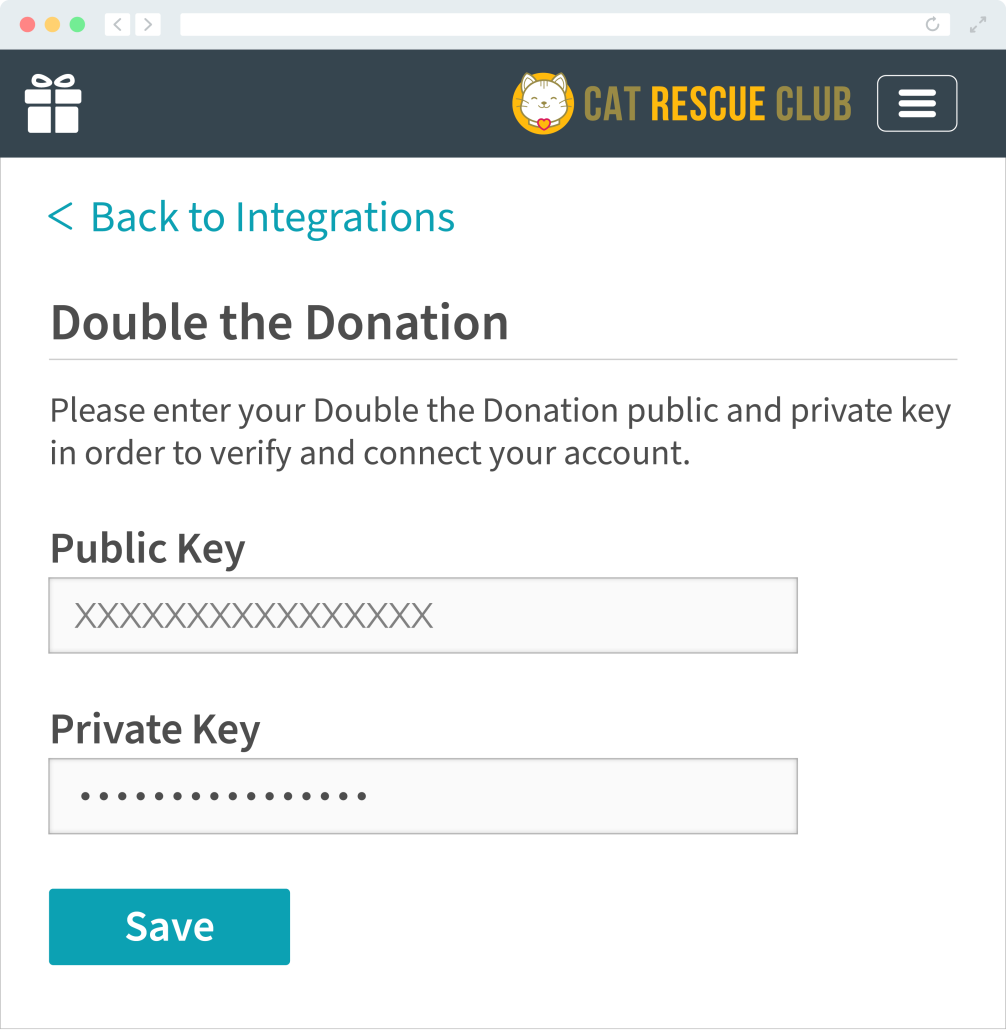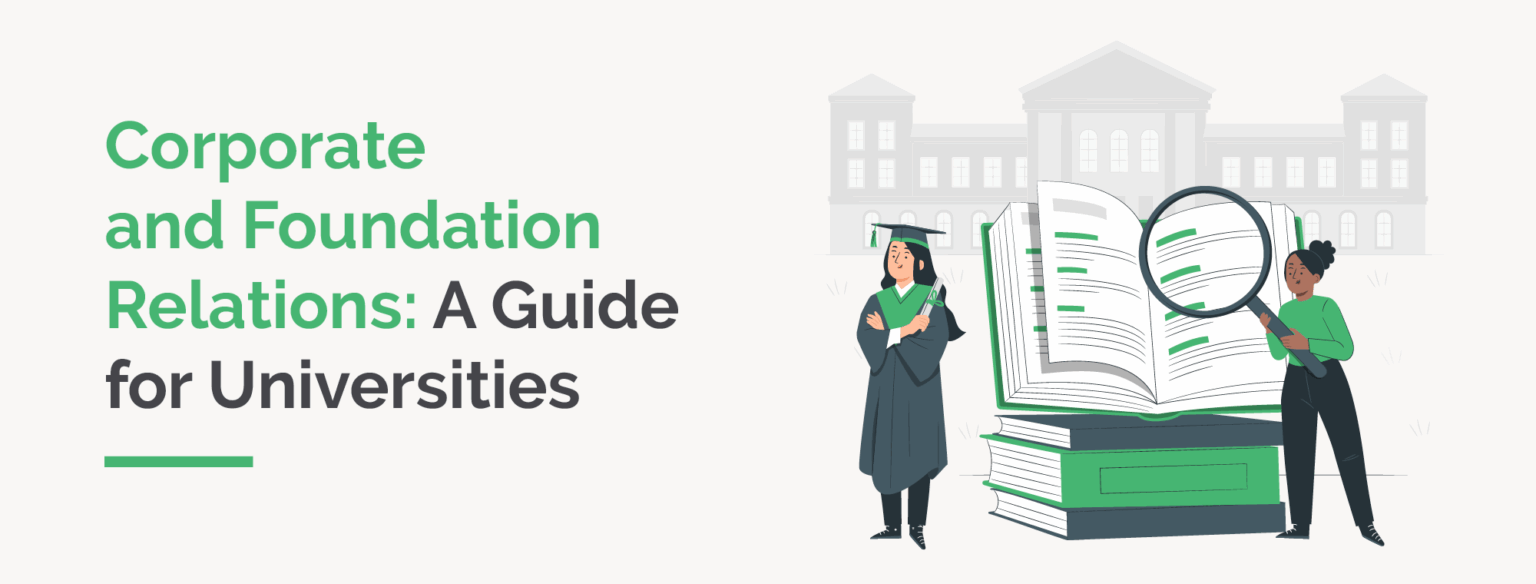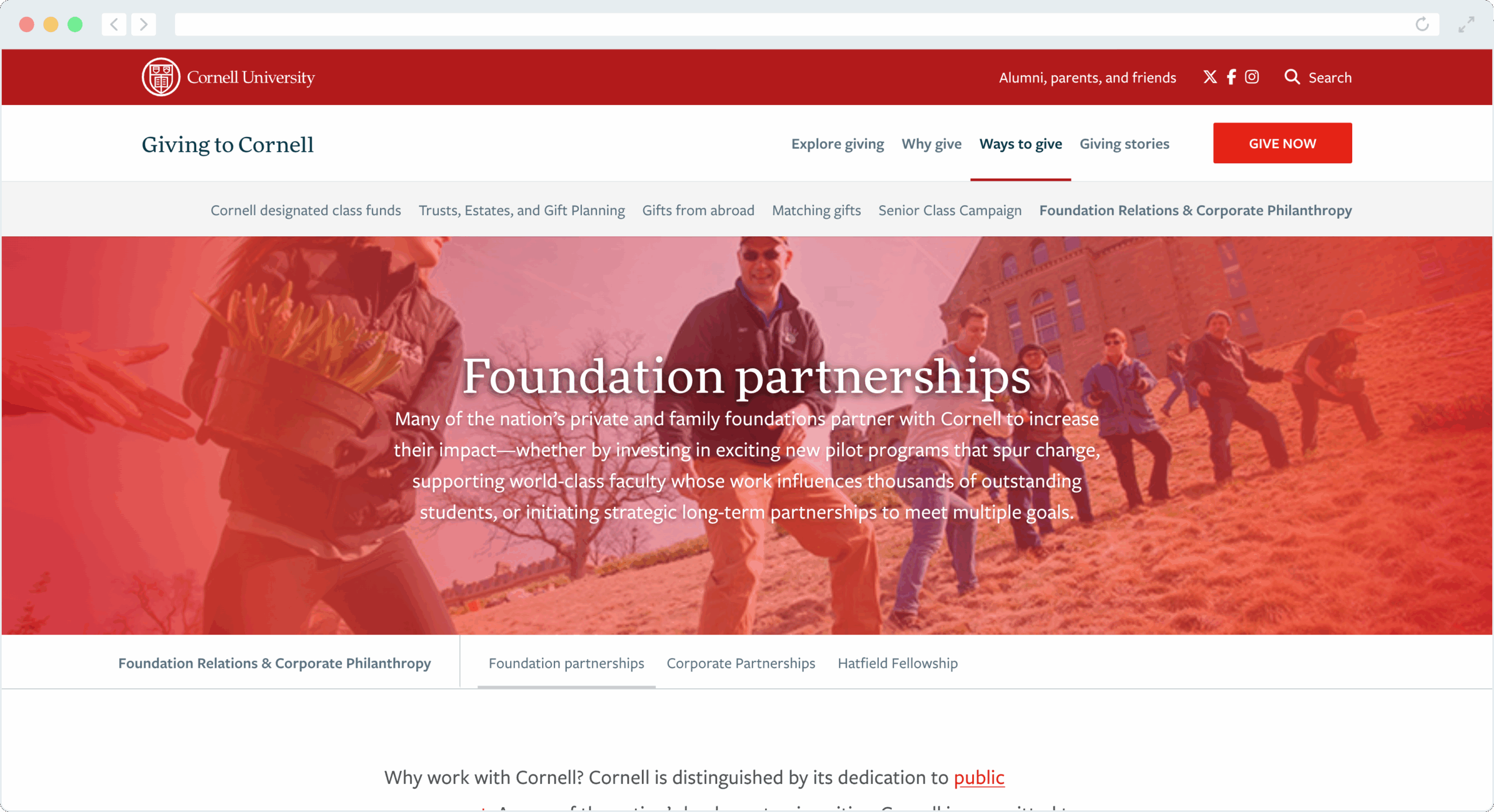How to Use Your Website to Track Challenge Grant Progress
/in Challenge Grants, Learning Center /by Sydney FayeHow to Create Urgency + Make Your Challenge Match Stand Out
/in Challenge Grants, Learning Center /by Adam WeingerNonprofits are always looking for innovative ways to engage donors and maximize their fundraising potential. Challenge matches are among the most effective strategies available, driving increased donations by creating urgency, doubling the impact of each gift, and motivating supporters to contribute. However, to fully harness the power of challenge grants and matches, nonprofits must engage donors effectively before, during, and after the campaign.
In this blog post, we’ll explore how to source interested donors, communicate with them effectively, and make the match process seamless. By following these strategies, your nonprofit can increase donor participation, track real-time progress, and ultimately raise more funds for your cause.
- Understanding Challenge Matches
- Sourcing Interested Donors for Challenge Grants
- Communicating with Donors: Keeping Them Informed
- Best Practices for Engaging Donors Throughout the Campaign
Understanding Challenge Matches
A challenge grant is a fundraising initiative in which a donor (or organization) pledges to match the funds raised by the nonprofit during a specific period. The most common type of challenge grant is a 1:1 match, meaning the donor matches every dollar raised by the nonprofit. These grants are typically time-sensitive, encouraging donors to give quickly to meet the fundraising goal.
By engaging donors effectively, these campaigns can raise significant amounts of money in a short time. However, to see maximum results, nonprofits must focus on targeting the right donors and making the process as simple and transparent as possible.
Sourcing Interested Donors for Challenge Grants
One of the first steps in running a successful challenge grant campaign is locating the right donors to participate. Luckily, your website is one of the most powerful tools at your disposal for identifying engaged donors. By analyzing how visitors interact with your website, you can identify individuals who are already interested in your mission and who may be inclined to contribute to your challenge match campaign.
Start by tracking key website actions such as:
- Donations: Visitors who have already donated are your most likely candidates for challenge grants. Review past donation data to see who has given at higher levels or made multiple contributions.
- Event Participation: If your nonprofit hosts events, track attendees who engage deeply with your content or share your mission. They may be prime candidates for becoming a match donor.
- Content Engagement: Track which visitors are spending time on high-impact pages (like your mission page, programs, or donation page). Those who engage with your cause are more likely to donate.
Communicating with Donors: Keeping Them Informed
Engaging donors throughout the campaign is essential to maintaining momentum and ensuring they stay involved in the process. Donors need to understand how their contributions are contributing to the overall goal and how their donations will be matched.
Real-Time Updates: Progress Bars and Countdown Timers
One of the best ways to engage donors and keep them informed is through real-time updates. This can be done using progress bars and countdown timers on your website.
- Progress Bars: Displaying a fundraising thermometer or progress bar on your donation page allows donors to see how close the campaign is to meeting the challenge match goal. This motivates donors to act quickly, especially as the goal nears.
- Countdown Timers: A visible countdown timer can create urgency by reminding donors that there is a limited amount of time to take advantage of the matching funds. The clock ticking down encourages donors to act before the opportunity ends.
These tools not only keep your donors informed but also encourage further engagement. As the match deadline approaches, donors may increase their contributions to help meet the goal, knowing their gift will be matched.
Transparency: Explaining the Impact of Their Donations
Donors want to know how their contributions are being used and the impact they will have. Be sure to explain exactly how the matching funds will support your cause. Whether it’s funding a specific program or helping meet a broader organizational goal, donors need to understand the direct effect of their gift.
Use stories and testimonials that connect their contribution to tangible outcomes. The more transparent you are about the impact of the funds raised, the more likely donors will feel motivated to give.
Best Practices for Engaging Donors Throughout the Campaign
Here are some best practices for keeping donors engaged and motivated throughout the challenge match, making your campaign stand out:
1. Regular Updates and Milestone Announcements
One of the most powerful tools for keeping your donors engaged throughout a challenge match campaign is consistent communication. Providing regular updates ensures that donors feel involved and see the progress of the campaign. It’s crucial to send out updates via multiple channels, such as email, social media, and your nonprofit’s website.
Updates can include key milestones like when the campaign has reached 50% of the goal, how much is left to unlock the match, or when you’re just a few donations away from hitting a target. These announcements not only keep donors informed but also reignite their excitement and encourage them to contribute again.
When donors see that their contributions are making a real impact, they are more likely to increase their giving or share the campaign with their networks. Timely and transparent updates build a sense of community and create a collective effort to achieve the campaign’s goals.
2. Acknowledge Donors Promptly
Acknowledging donors promptly is crucial for fostering a deeper connection to your nonprofit and campaign. As soon as a donation is made, it’s essential to thank the donor personally, whether through a thank-you email, a phone call, or a thank-you card. Personalized messages that highlight the donor’s specific contribution—such as how their donation will help unlock matching funds—help make the donor feel valued.
The acknowledgment should also reiterate the impact of their gift, letting them know that their support is making a meaningful difference. Recognizing their generosity promptly not only shows gratitude but also reinforces the importance of their role in the campaign. It builds trust and encourages further participation, fostering long-term relationships that are vital for future campaigns.
3. Recognize Donors Publicly
Public recognition is a key component of donor engagement. Recognizing your donors publicly, especially major donors or those who contribute large sums, helps to build goodwill and increase their satisfaction with the campaign. Publicly thanking your donors on social media, in email campaigns, and on your website allows others to see the impact of the contributions, creating a sense of pride and accomplishment for the donors.
It also serves as a form of social proof, encouraging others to contribute when they see their peers being recognized for their support. Acknowledging donors publicly can be done through a donor wall on your website, shout-outs on social media platforms, or even at donor recognition events. This public recognition shows your appreciation and encourages others to get involved, knowing they, too, will be acknowledged for their contributions.
4. Maintain Transparency and Trust
Maintaining transparency throughout a challenge match campaign is critical for building trust and fostering donor loyalty. Donors need to understand how their contributions are helping to meet the campaign’s goals. By providing clear and consistent updates on how much has been raised, how close the campaign is to reaching its target, and how much time is left, you ensure that donors remain confident in the process.
Transparency also involves clearly explaining how the matching funds work, where the money is going, and the tangible impact it will have. This openness encourages donors to stay engaged, as they feel assured that their money is being used wisely. Transparency also builds credibility and trust, which are essential for cultivating long-term relationships with donors. Regular updates with accurate and honest information about campaign progress will keep donors motivated and excited about being part of the campaign.
Wrapping Up & Next Steps
Engaging donors in challenge grants and challenge matches is essential for maximizing your nonprofit’s fundraising efforts. By using real-time updates, simplifying the matching process, and maintaining transparent communication, you can keep your donors involved and motivated throughout the campaign.
To ensure success:
- Leverage your website and digital tools to keep donors informed.
- Simplify the donation and matching process using automated tools.
- Engage donors consistently with progress updates and recognition.
By following these strategies, your nonprofit can effectively engage donors, maximize the impact of challenge grants, and ultimately raise more funds to support your mission.
Raise Even More with Employee Matching Gifts!
In addition to challenge grants, employee matching gifts can further boost your fundraising efforts. With Double the Donation, your nonprofit can easily identify matching gift opportunities and streamline the process. Start raising more today by integrating employee matching gifts into your campaigns! Get a free demo of Double the Donation to see how our tools can help.
How to Engage Donors in Challenge Grants, Challenge Matches
/in Challenge Grants, Learning Center /by Sydney FayeNonprofits are always looking for innovative ways to engage donors and maximize their fundraising potential. Challenge grants and challenge matches are among the most effective strategies available, driving increased donations by creating urgency, doubling the impact of each gift, and motivating supporters to contribute. However, to fully harness the power of challenge grants and matches, nonprofits must engage donors effectively before, during, and after the campaign.
In this blog post, we’ll explore how to source interested donors, communicate with them effectively, and make the match process seamless. We’ll cover how to use website engagement, employment data, and donor tracking tools to identify and engage the right donors for challenge match campaigns. By following these strategies, your nonprofit can increase donor participation, track real-time progress, and ultimately raise more funds.
- Understanding Challenge Grants and Challenge Matches
- Sourcing Interested Donors for Challenge Grants
- Communicating with Donors: Keeping Them Informed
- Making it Easy for Donors to Issue Their Grants
- Best Practices for Engaging Donors Throughout the Campaign
Understanding Challenge Grants and Challenge Matches
Before diving into how to engage donors, it’s important to define what challenge grants and challenge matches are and why they are so effective for nonprofits.
Challenge Grants:
A challenge grant is a fundraising initiative in which a donor (or organization) pledges to match the funds raised by the nonprofit during a specific period. The most common type of challenge grant is a 1:1 match, meaning the donor matches every dollar raised by the nonprofit. These grants are typically time-sensitive, encouraging donors to give quickly to meet the fundraising goal.
Challenge Matches:
A challenge match is similar to a challenge grant, but it focuses on matching contributions rather than offering a lump sum at the end. For example, a corporate sponsor might agree to match donations up to $100,000 during a two-week campaign.
Both challenge grants and challenge matches work by creating a sense of urgency, motivating donors to contribute more. The match component encourages people to give, knowing their contribution will be doubled, tripled, or more. The deadline aspect inspires donors to act fast.
By engaging donors effectively, these campaigns can raise significant amounts of money in a short time. However, to see maximum results, nonprofits must focus on targeting the right donors and making the process as simple and transparent as possible.
Sourcing Interested Donors for Challenge Grants
One of the first steps in running a successful challenge grant campaign is identifying the right donors to participate. Targeting engaged individuals on your website and using data to identify potential contributors are essential for sourcing donors who are most likely to participate in your campaign.
Your website is one of the most powerful tools at your disposal for identifying engaged donors. By analyzing how visitors interact with your website, you can identify individuals who are already interested in your mission and who may be inclined to contribute to your challenge match campaign.
Start by tracking key website actions such as:
- Donations: Visitors who have already donated are your most likely candidates for challenge grants. Review past donation data to see who has given at higher levels or made multiple contributions.
- Event Participation: If your nonprofit hosts events, track attendees who engage deeply with your content or share your mission. They may be prime candidates for becoming a match donor.
- Content Engagement: Track which visitors are spending time on high-impact pages (like your mission page, programs, or donation page). Those who engage with your cause are more likely to donate.
Communicating with Donors: Keeping Them Informed
Engaging donors throughout the campaign is essential to maintaining momentum and ensuring they stay involved in the process. Donors need to understand how their contributions are contributing to the overall goal and how their donations will be matched.
Real-Time Updates
One of the best ways to engage donors and keep them informed is through real-time updates. This can be done using…
- Progress Bars: Displaying a fundraising thermometer or progress bar on your donation page allows donors to see how close the campaign is to meeting the challenge match goal. This motivates donors to act quickly, especially as the goal nears.
- Countdown Timers: A visible countdown timer can create urgency by reminding donors that there is a limited amount of time to take advantage of the matching funds. The clock ticking down encourages donors to act before the opportunity ends.
These tools not only keep your donors informed but also encourage further engagement. As the match deadline approaches, donors may increase their contributions to help meet the goal, knowing their gift will be matched.
Transparency
Donors want to know how their contributions are being used and the impact they will have. Be sure to explain exactly how the matching funds will support your cause. Whether it’s funding a specific program or helping meet a broader organizational goal, donors need to understand the direct effect of their gift.
Use stories and testimonials that connect their contribution to tangible outcomes. The more transparent you are about the impact of the funds raised, the more likely donors will feel motivated to give.
Making it Easy for Donors to Issue Their Grants
Once your donors are engaged and ready to contribute, the next step is making it as easy as possible for them to contribute their grants.
In order to do so, you’ll want to ensure that your donation page is user-friendly and optimized for quick donations. Provide clear instructions on how donors can make their contribution and issue a match.
For donors who are contributing through their DAFs (Donor Advised Funds), provide step-by-step instructions on how they can direct their fund to your nonprofit and recommend grants for matching. This makes the process seamless for them and ensures they are engaged throughout the entire campaign.
Best Practices for Engaging Donors Throughout the Campaign
Here are some best practices for keeping donors engaged and motivated throughout the challenge match campaign:
1. Regular Updates and Milestone Announcements
Keep your donors informed by sending regular updates through email, social media, and on your website. Share milestones along the way, such as when you reach 50% of the goal or how much is left to unlock the match.
2. Acknowledge Donors Promptly
Thank your donors as soon as they contribute. Personalized thank-you messages, especially those that highlight the impact of their gift, will increase their connection to the campaign and encourage further engagement.
3. Recognize Donors Publicly
Public recognition can go a long way in building goodwill and encouraging more contributions. Thank your major donors on social media, in email campaigns, and on your website. Recognizing their support makes them feel valued and appreciated.
4. Maintain Transparency and Trust
Keep the match process transparent and consistent. Donors need to know how their gifts are contributing to the overall goal. Update them frequently on how close the campaign is to reaching its target and how much time is left.
Wrapping Up & Next Steps
Engaging donors in challenge grants and challenge matches is essential for maximizing your nonprofit’s fundraising efforts. By using real-time updates, simplifying the matching process, and maintaining transparent communication, you can keep your donors involved and motivated throughout the campaign.
To ensure success:
- Leverage your website and digital tools to keep donors informed.
- Simplify the donation and matching process using automated tools.
- Engage donors consistently with progress updates and recognition.
By following these strategies, your nonprofit can effectively engage donors, maximize the impact of challenge grants, and ultimately raise more funds to support your mission.
Raise More with Employee Matching Gifts!
In addition to challenge grants, employee matching gifts can further boost your fundraising efforts. With Double the Donation, your nonprofit can easily identify matching gift opportunities and streamline the process. Start raising more today by integrating employee matching gifts into your campaigns! Get a free demo of Double the Donation to see how our tools can help.
Why Challenge Grants Are a Top Nonprofit Fundraising Tool
/in Learning Center, Challenge Grants /by Adam WeingerFor nonprofit organizations, the challenge of raising enough funds to support their mission can often feel overwhelming. With limited resources and a growing need for innovative strategies, how can your nonprofit increase donor engagement and maximize fundraising potential? The answer lies in challenge grants—one of the most powerful and effective tools in nonprofit fundraising.
A challenge grant, also known as a matching grant, is a powerful fundraising strategy in which a donor or organization pledges to match contributions raised by a nonprofit, often within a set time frame. These campaigns leverage the power of matching funds to create urgency, increase participation, and ultimately boost donations.
But what makes challenge grants so effective? In this blog post, we’ll explore why challenge grants are such a successful tool for nonprofits, how they can drive engagement, and the incredible outcomes they create for fundraising campaigns.
- What is a Challenge Grant?
- Why Challenge Grants Work: The Psychological Impact on Donors
- How Challenge Grants Drive Increased Revenue
- The Benefits of Challenge Grants Beyond Financials
- How to Use Challenge Grants to Engage Donors
What is a Challenge Grant?
A challenge grant is a fundraising tactic where a donor (or group of donors) offers to match donations raised by the nonprofit organization, often up to a certain amount or during a specific period of time. For example, a donor may pledge to match $50,000 in donations made within 30 days.
Challenge grants are highly effective because they create a sense of urgency and motivate donors to act quickly, knowing their donations will be doubled or even tripled. This matching opportunity encourages both existing and new donors to contribute at higher levels, which ultimately leads to greater revenue for the nonprofit.
One of the most attractive elements of a challenge grant is that it encourages reciprocity. When donors know their contribution will be matched, they feel a stronger connection to the cause, increasing both the likelihood of donation and the size of their contributions.
In fact, research shows that 84% of donors are more likely to give when a matching gift is available, and 36% report that they would not have contributed without the matching opportunity (source: Double the Donation).
Why Challenge Grants Work: The Psychological Impact on Donors
Challenge grants are not just about financial incentives—they tap into the psychological factors that drive donor behavior. The prospect of having one’s contribution matched has a profound impact on how donors approach giving. Here’s why:
1. Amplification of Impact
The concept of a doubled donation resonates strongly with donors. When someone gives $100 and knows that their gift will be matched, they feel as though they’ve contributed $200. This sense of increased impact encourages donors to give larger amounts and motivates them to contribute sooner.
2. Urgency and Time Sensitivity
Challenge grants are typically time-bound, which creates a sense of urgency. Donors are more likely to act quickly when they know there’s a limited window to take advantage of the matching opportunity. Research shows that campaigns with deadlines see higher participation rates, as donors don’t want to miss out on the opportunity to have their contributions matched.
3. Social Proof and Donor Participation
The social influence of challenge grants also plays a key role. As the fundraising campaign progresses, seeing the total raised toward the challenge goal can motivate other donors to act. Donors often want to be part of a successful campaign and to see their contributions make a real difference. Progress tracking tools like real-time progress bars and fundraising thermometers can further enhance this sense of social proof and inspire more people to give.
How Challenge Grants Drive Increased Revenue
When implemented correctly, challenge grants can dramatically increase the amount of funds raised during a campaign. The structure of challenge grants inherently leads to higher donor participation and larger gifts.
1. Matching Gifts Multiply Contributions
The most obvious benefit of challenge grants is that they double (or more) the impact of each donation. When donors know their gift will be matched, they are more likely to give larger amounts, leading to a higher average donation. According to recent research, campaigns with matching opportunities raise 3-5 times more during peak giving seasons than those without.
2. Attracting New Donors
Challenge grants are a great way to attract new donors to your organization. The presence of a matching gift provides a compelling reason for first-time donors to contribute. This increased engagement helps build a larger donor base, leading to more long-term financial support.
3. Increased Donation Frequency
Challenge grants also encourage repeat donations. When donors contribute to a campaign and see that their gift has been matched, they are more likely to give again in the future. This cycle of giving builds a sustainable funding model and ensures that your nonprofit has access to ongoing support.
4. Higher Levels of Corporate Involvement
In addition to individual donors, corporate partners can also play a crucial role in challenge match campaigns. Challenge grants offer companies the opportunity to maximize their philanthropic impact and engage other donors in giving, too.
The Benefits of Challenge Grants Beyond Financials
While challenge grants are highly effective at raising funds, they offer several non-financial benefits that can have a lasting impact on your nonprofit:
1. Strengthened Relationships with Donors
When donors contribute to a campaign with a matching gift, they feel more connected to your cause. Challenge grants provide a platform for fostering deeper relationships with both new and existing donors. By giving them the opportunity to double their impact, you make them feel more engaged and invested in the success of your nonprofit.
2. Building Donor Loyalty
Challenge match campaigns can create a sense of community among your supporters. Donors are more likely to continue their support if they feel that their contributions are valued and have made a meaningful difference. This results in increased donor loyalty and higher retention rates.
3. Boosted Brand Awareness
When challenge grants are well-publicized, they can help raise awareness of your nonprofit’s work. Whether through social media, email campaigns, or newsletters, your challenge match campaign provides a great opportunity to showcase your mission and attract new supporters.
How to Use Challenge Grants to Engage Donors
The success of your challenge match campaign depends heavily on how you engage your donors throughout the campaign. Here are some strategies to keep donors involved and excited about your challenge:
1. Promote the Match Opportunity
Make the matching opportunity prominent and easy to understand on your website, in emails, and on social media. Donors need to know that their gift will be matched and how that will impact the campaign. Use language like “Double Your Impact” or “**Your gift will be doubled!” to highlight the opportunity.
2. Regular Updates and Milestones
Keep donors informed about how much has been raised, how much is left to meet the match goal, and what the campaign’s progress is. Use real-time tracking tools like progress bars or fundraising thermometers to visually display the campaign’s progress. This keeps donors engaged and motivated to contribute more to reach the match.
3. Create a Sense of Urgency
The time-bound nature of challenge grants creates a natural sense of urgency. Remind your donors regularly that they have a limited amount of time to take advantage of the match. Use countdown timers or email reminders to keep the deadline top of mind.
4. Recognize Donors for Their Contributions
Donors love to feel appreciated. Publicly acknowledge their support through social media shout-outs, donor walls on your website, and personalized thank-you messages. This recognition strengthens their connection to your cause and encourages them to donate again.
Wrapping Up & Next Steps
Challenge grants are one of the most effective fundraising tools available to nonprofits. Not only do they boost donations and create urgency, but they also strengthen donor relationships, attract new supporters, and raise awareness for your cause.
- Set a clear match goal and make it visible on your website, social media, and email campaigns.
- Use real-time progress tracking to keep donors engaged and motivated.
- Regularly communicate the urgency of the match opportunity to encourage quick action.
By following these steps, your nonprofit can increase donor engagement, maximize revenue, and achieve its fundraising goals with a well-executed challenge match campaign.
Raise More with Employee Matching Gifts!
In addition to challenge grants, employee matching gifts offer another excellent opportunity to increase your fundraising success. With Double the Donation, your nonprofit can easily identify matching gift opportunities and track progress to maximize the impact of these funds. Start raising more today by integrating employee matching gifts into your campaigns; get a demo of Double the Donation to see how our tools can help!
Fundraising Event Software: The Ultimate Buyer’s Guide
/in Learning Center, Learning Center /by Sydney FayeIt takes a lot to plan and execute a nonprofit event. From getting started with goal-setting and budgeting through organizing and promoting your event experience and finally hosting and engaging with donors, there’s a lot to juggle. Luckily, the right fundraising event software can make organizing an impactful event a breeze.
But even the software buying process can be overwhelming if you don’t know what you’re looking for. That’s where this helpful guide comes in handy!
Here, we’ll cover everything you need to know about event fundraising tools, including:
- Why Invest in Fundraising Event Software?
- Features to Consider For Your Fundraising Event Software
- How to Make Your Fundraising Event Software Choice
At Double the Donation, we’ve worked with many different providers in the space, and we gathered some of our top tips for choosing the best fundraising event software for your team. In the end, these practices should help guide your decision-making process as you continue to develop your perfect toolkit of nonprofit technology.
Not to mention, you’ll be all set to get started with optimal fundraising events with the right tools to power your efforts. Let’s begin!
Why Invest in Fundraising Event Software?
Fundraising event software is a critical component of any organization’s fully built-out tech stack. After all, a significant portion of many nonprofits’ overall revenue is collected through engaging fundraising events. And the right tools can make organizing and hosting as easy and effective as ever. That means more of your team’s time can be reallocated to other mission-valuable activities!
Not to mention, more and more fundraising events are involving increasingly technical aspects. Virtual and hybrid events are becoming all the rage. Even in-person gatherings are becoming dependent on behind-the-scenes software and user-facing technology to run smoothly and elevate the event experience.
Thus, if your organization is looking to develop or optimize your event fundraising strategy, investing in the right tools to power your efforts is essential.
Features to Consider For Your Fundraising Event Software
The term “fundraising event software” can encompass a lot of different kinds of tools. And each one offers key benefits to your organization, the events you organize, and the individuals who support your efforts.
Let’s explore a few of these key functions.
(Top tip: As you walk through the following types of features and functionality commonly associated with nonprofit event software, keep in mind that you may have to prioritize offerings in order of importance. Consider flagging elements as “must-haves” and “nice-to-haves.”)
Online Event Pages
In order to pull off an effective event, it’s crucial that your supporters are aware of the opportunity. And one of the best ways to spread the word about upcoming events involves engaging online event pages or microsites.
Here’s what this event software functionality should include:
- Pre-built and customizable web page templates;
- Landing page and microsite options.
- Personalized branding that matches your organization’s existing materials;
- Mobile-optimized pages that are easy to use on screens of all shapes and sizes;
- Search engine optimization and accessibility tools;
- The ability to embed a corporate matching gift search tool that uncovers match-eligible donations.
Ticketing Services
Make sure your team and your attendees are prepared for your event with intuitive ticketing functionality. Consider these key features:
- Easy-to-use online ticketing forms;
- Free and paid ticket purchases for in-person and virtual events;
- Online RSVP management and automated receipting;
- Customizable questions, such as meal preferences and t-shirt sizes;
- Multiple ticketing tiers and packages.
Payment & Donation Processing
Regardless of whether you’re hosting free or paid events, it’s essential that your team has the tools for processing payments from supporters. This should include:
- Accepting payments online and in-person;
- Leveraging multiple payment methods;
- Processing payments for event tickets, merchandise, pledges, and more;
- Collecting donations, in addition to ticketing and other sales;
- Promoting matching gifts throughout the donation process.
Peer-to-Peer Fundraising Capability
Peer-to-peer fundraising and nonprofit events often go hand-in-hand. Some of the most impactful social fundraising efforts cumulate in a final event to drive engagement and celebrate success. Think—run/walk/rides and other “a-thon” style events.
Here are a few peer-to-peer fundraising features to consider in your search for nonprofit event technology:
- Online event participant registration;
- Customizable participant fundraising pages;
- Gamification tools, such as fundraising thermometers, badges, and prizes;
- Donation and pledge processing and fulfillment.
Auction Management
Charity auctions are many nonprofit organizations’ most profitable fundraising events time and time again. So when it comes to event software buying, it’s a good idea to keep auction tools in mind. These typically include:
- Item procurement and tracking capabilities;
- Facilitation of live and silent in-person, virtual, and hybrid auction events;
- Online and mobile bidding functionality for attendees;
- Real-time bid tracking and other analytics.
Data Reporting
Nonprofit events produce a lot of powerful data. It’s important to have the tools you need to collect, analyze, and leverage that information for the greatest results! That’s where an event software’s data reporting functionality comes in.
Consider these key features:
- Event attendee supporter profiles to track ongoing engagement;
- Budgeting and revenue tools to determine ROI calculations;
- Real-time event data reporting;
- Birds-eye view and in-depth options.
Matching Gift Automation
Did you know that nearly 27 million individuals work for companies that match gifts? But approximately 78% of this group has no idea that their employers offer these programs?
That’s why increasing awareness of match opportunities is essential—and your event software can help! Matching gift software, or event fundraising software with a dedicated matching gift component, should:
- Collect supporter employment information through email domain screening or with an integrated company search tool;
- Provide donors and event attendees with employer-specific matching gift guidelines (eligibility criteria, online forms, etc.);
- Automatically follow up with match-eligible or unknown donors post-engagement to remind individuals about matching opportunities and drive more successful matches to completion.
Organizations that enhance matching gift efforts by utilizing top software offerings tend to see elevated events and other fundraising experiences. In many cases, it’s the equivalent of a two-for-one sale on charitable donations!
Sponsorships Management
Corporate sponsorships play a key role in the success of nonprofit fundraising events, providing crucial financial support, in-kind donations, and promotional benefits. To maximize sponsorship revenue and streamline management, nonprofits should leverage event fundraising software with dedicated sponsorship functionality.
These tools should:
- Track sponsor outreach and commitments to ensure seamless communication and follow-up.
- Manage sponsorship tiers and benefits by organizing different sponsorship levels and the perks associated with each.
- Facilitate sponsorship agreements by storing contracts, tracking deliverables, and automating reminders.
- Provide branded recognition opportunities across event pages, ticketing platforms, and digital marketing materials.
- Generate sponsorship impact reports to demonstrate ROI and strengthen long-term partnerships.
Corporate Volunteer Functionality
More than likely, your organization’s events are going to rely on dedicated volunteers to run smoothly and maintain efficient and cost-effective operations. And many of these individuals can even qualify for volunteer incentives (such as volunteer grants and paid volunteer time off) through their employers! For that reason, equipping your team with the right corporate volunteer software is a must.
These kinds of tools should:
- Collect employment information as supporters register for volunteer events;
- Screen against a volunteer incentives database to uncover the opportunities;
- Provide volunteers with company-specific instructions and submission form links;
- Automatically follow up with actionable, targeted reminders.
Integrations
Expand your event software’s reach with seamless integrations—especially with the tools your organization already uses on a day-to-day basis.
Software integrations essentially form unified systems between varying platforms, allowing different tools to speak to one another. Therefore, integrating your event fundraising software with your organization’s existing fundraising solutions empowers your technology to do more with less manual tasks and configurations.
As you consider fundraising event software integrations, this might include:
- Online donation tools;
- Peer-to-peer fundraising platforms;
- Data management systems;
- Corporate giving software;
- Volunteer management software;
- Marketing and outreach solutions.
Selecting the right event software is a crucial step in maximizing the success of your fundraising efforts. Whether you’re focused on streamlining ticketing, optimizing donation processing, engaging supporters through peer-to-peer fundraising, or enhancing corporate giving opportunities, the right tools can make a significant impact.
By leveraging key features like matching gift automation, corporate volunteer functionality, data reporting, and more, your organization can unlock new revenue streams, strengthen donor and volunteer relationships, and ultimately drive greater event success. Not to mention, seamless integrations ensure your event software works in harmony with your existing fundraising and donor management tools.
How to Make Your Fundraising Event Software Choice
As you work to narrow down your event technology options, here are a few best practices to keep in mind:
- Set a software budget to guide your buying decisions. One of the best ways to narrow down your available options is to go into the buying process with a set budget in mind. This way, you can devote your time to the software your organization can afford. As you look for cost-effective solutions, be sure to consider base price, startup costs, ongoing fees, expansions or add-ons, scalability, and more.
- Consider bundling event tools with a comprehensive fundraising platform. While some event tools are made available in an à la carte or piecemeal format, others are offered as a bundle in an overall fundraising software package. In the latter scenario, your event-specific technology may be integrated directly with an online donation tool, CRM, and more for an all-in-one solution. Many organizations prefer this type of software collection for ease of use and seamless communication between platforms.
- Seek software with matching gift functionality. Beyond typical event software features, one element that can drastically improve your team’s fundraising efforts—event-based and otherwise—is matching gift functionality. Corporate matching gifts enable many donors and event attendees to double their impact on your cause. Luckily, tools like Double the Donation integrate with top event platforms to enable seamless match identification and automated follow-ups.
- Request a demo to see prospective tools in action. Before you make your final decisions, it’s a good idea to request some demos. Many companies can provide access to a pre-recorded video, though a live demo offers a more personalized encounter. As you experience the software in action, consider how the tools will look from a user’s perspective. And don’t be afraid to ask questions, either!
With the right event software in place, your nonprofit can create more engaging experiences, increase donor and volunteer participation, and amplify its fundraising impact for years to come. It’s not something you want to miss out on.
Final Thoughts
In the recent past, events of all kinds have become increasingly technology-based—from innovative in-person elements to virtual and hybrid experiences. And it’s important that your nonprofit has the tools to keep up with the times!
As you look to revolutionize your organization’s event offerings with powerful software, we recommend exploring Double the Donation’s integration partners. Many of these top-of-the-line fundraising software providers offer impactful tools that can bring your event endeavors to the next level. Then, don’t forget to factor matching gifts into your strategy, as well!
Want to learn more? Check out these other educational resources to elevate your organization’s event, workplace giving, and overall fundraising strategies:
- Top Peer-to-Peer Fundraising Software (What to Look For). Nonprofit events and peer-to-peer fundraising go hand in hand. Explore our complete buyer’s guide to determine what your team should look for in a social fundraising solution.
- The Expert’s Guide to Buying Fundraising Software. Fundraising software comes in all shapes and sizes. Find out what other solutions are available for nonprofits like yours and how to ensure you find the right provider for your needs.
- The Complete Guide to In-Kind Donations for Nonprofits. Find out how your team can make the most of in-kind giving (or non-cash gifts) for your next event! Our complete guide shares everything you need to know.
16 CSR Statistics Nonprofits & Companies Should Know
/in Learning Center, Corporate Consulting /by Adam WeingerNonprofit Advertising: The Best Advice & Persuasive Examples
/in Learning Center, Marketing Strategies /by Adam WeingerThe online space grows more competitive each day. Nonprofits are up against big-name companies, vying for consumers’ attention. If you’re grasping at straws and still aren’t capturing prospects’ attention, it might be time to try nonprofit advertising.
Advertising is often perceived as a misuse of donations, but it’s surprisingly effective. There’s a reason companies invest in paid advertising – it works! Where traditional marketing approaches fall short, paid advertising can elevate your cause and extend your reach to new audiences.
Whether you’re just getting started or looking to refine your existing efforts, this guide will provide everything you need to create a high-ROI nonprofit advertising strategy, including everything from common types of ads to real-world examples you can emulate. Here’s what we’ll cover:
- Understanding Nonprofit Advertising
- 7 Types of Nonprofit Ads
- Steps to Creating Your Nonprofit Advertising Strategy
- 3 Nonprofit Advertising Examples
Whether you’re investing in digital nonprofit advertising or creating newspaper ads, get ready to brainstorm how ads can support your cause and get your services in front of new audiences.
Understanding Nonprofit Advertising
The world of nonprofit advertising is expansive, so let’s start with the fundamentals, kicking off with a basic definition.
What Are Nonprofit Ads?
Also referred to as charity advertising, nonprofit ads are paid ads that nonprofits use to promote their services and fundraisers. Advertising includes digital platforms such as paid search ads and social media ads, as well as traditional advertising methods such as community radio and print ads.
While paid ads can make a notable difference in your outreach, know they’re just one part of your marketing strategy. “Nonprofit marketing” refers to all the activities your nonprofit leverages to promote its brand and mission, while advertising is a specific subset of nonprofit marketing that refers strictly to paid channels.
In the for-profit world, companies create billboards, promotional materials for TV, and digital ads to promote goods and services. Advertising looks a little different for nonprofits, though. Instead of promoting a tangible product, nonprofit advertising is used to “sell” a cause. When done effectively, charity ads educate target audiences about the mission, goals, and services of the organization, as well as solicit donations or other forms of support.
What’s The Difference Between Inbound and Outbound Marketing?
Inbound and outbound marketing are two distinct marketing approaches, each with unique strategies and benefits. For a balanced marketing plan, use both paid and free channels to reach your audience without blowing your budget out of the water. Let’s compare these two strategies:
- Inbound marketing, often referred to as “pull marketing,” is designed to attract prospects by pulling them in with content related to their interests. Common inbound channels include search engine optimization (SEO), blogs, videos, podcasts, and organic social media content. Inbound marketing requires time to develop and share quality content. SEO, in particular, is a crucial form of inbound marketing. By targeting relevant keywords, creating valuable content, and improving the overall user experience of your site, you can attract more organic traffic. While it takes time to see results from SEO, the long-term benefits include a steady stream of engaged visitors and reduced reliance on paid advertising.
- Outbound marketing is commonly called “push marketing” since it involves pushing messages out to a wide audience, regardless of whether the audience has expressed interest in your mission. Typically associated with paid strategies, commonly used outbound channels include TV commercials, pay-per-click (PPC) campaigns, direct mail campaigns, newspaper ads, and social media ads. Outbound marketing can deliver quick results and is especially useful for time-sensitive campaigns and events.
Both inbound and outbound marketing have their place in a comprehensive marketing strategy. To strike a balance, we suggest using inbound tactics like optimizing your nonprofit’s website for search engines. This strategy helps build a strong online presence and attract supporters organically. Once you create valuable content, amplify its reach using paid ads.
This approach allows you to leverage the strengths of both strategies: the long-term sustainability of inbound marketing and the immediate impact of outbound marketing.
Why Should Nonprofits Use Advertising?
Nonprofit advertising is undoubtedly worth the investment. From securing new donors to connecting with beneficiaries, you can achieve a lot with persuasive ads.
If you’re not convinced you should spend your hard-earned donations on promoting your work, here are a few common reasons why you should:
- Drive high-quality conversions. Getting Attention’s nonprofit advertising guide explains that with powerful ads, “you can convert an ordinary viewer into a valuable supporter. You might shoot for conversions like donations, volunteer sign-ups, contact form completions, event registrations, or shares to social media sites.” Plus, many platforms have audience targeting capabilities, allowing you to narrow your audience and deliver valuable content to likely supporters.
- Build a stronger, more recognizable brand. Nonprofit advertising puts your digital content in front of more prospects than word-of-mouth alone. Existing supporters will also be met with your charitable ads, keeping your cause front of mind even when they haven’t interacted with you for a while.
- See major returns on low-cost efforts. In some cases, you only pay when a user clicks your ad. Many platforms, like Google Ads, offer discounts and free platform use to verified nonprofits. Even when you pay out of pocket for ads, you don’t have to pay to generate revenue from nonprofit ads. This Google Ad Grant Impact Report explains that view-through revenue—revenue from donors who saw but didn’t click on an ad—accounts for 35% of all giving sourced from digital ads.
For positive results, put in time and effort into creating authentic ads. Otherwise, you’ll waste your budget that could be better used supporting other areas of your mission.
Choosing Between Inbound vs. Outbound Strategies
When choosing between inbound and outbound strategies, nonprofits should consider their goals. Whether the aim is immediate visibility, sustainable growth, or building credibility, both outbound advertising and inbound SEO offer unique advantages.
Let’s take a look at the specific benefits of advertising vs. SEO.
Why Use Advertising:
- Immediate Visibility: Advertising provides quick exposure and immediate results, ideal for time-sensitive campaigns or events.
- Targeted Reach: Paid ads can be highly targeted, ensuring your message reaches the right audience.
- High-Quality Conversions: With compelling ads, you can drive valuable actions like donations, volunteer sign-ups, and event registrations.
Why Use SEO:
- Sustainable Growth: SEO helps organizations build a long-term online presence, attracting organic traffic consistently.
- Cost-Effective: Once established, SEO can provide ongoing benefits without additional costs.
- Credibility and Trust: Content that ranks well on Google also tends to be original, valuable, and reliable. Therefore, high-quality, optimized content enhances your nonprofit’s credibility, fostering long-term supporter relationships.
SEO is ideal for promoting your nonprofit’s services, products, and annual events that attract wide audiences. Meanwhile, you might reserve ads for direct fundraising campaigns, other ways to give, localized offerings, and one-time events.
By understanding the strengths of both approaches, your nonprofit can strategically decide whether to prioritize immediate impact with advertising, sustainable growth with SEO, or ideally both for your marketing plan.
What Are the Challenges of Charity Advertising?
When used efficiently, nonprofit ads can help you make incredible strides for your mission. However, you’ll need to overcome some hurdles.
Here are some challenges you’ll want to get in front of when planning your promotional strategies:
- Donors want their funds to go directly toward your mission. They might resist the idea of their contributions being spent on paid ads. That’s why some nonprofits are hesitant to pay for advertising — they’re worried about what existing prospective donors will think of them.
- You’ll need to dedicate time to managing your ads. Some organizations don’t have the staff or time to create their ads. That goes for monitoring your campaigns and making adjustments to maximize results, too. You shouldn’t use a set-it-and-forget-it approach. Not to mention, some advertising platforms have a considerable learning curve. We recommend working with a nonprofit advertising expert to mitigate these challenges.
- Conveying your message can be challenging. Ads are notorious for seeming inauthentic. When possible, use storytelling components like original images to make your ads appear genuine.
To preemptively overcome these challenges, choose affordable advertising channels and be authentic in your promotion. We also recommend working with a nonprofit advertising agency. These professionals devote their time to managing campaigns backed by their technical expertise, so you can focus on other activities.
How Can I Work Nonprofit Ads Into My Budget?
Considering that nonprofit advertising is a paid form of marketing, you’ll need to allocate sufficient funds toward it.
A common misconception is that paid advertising is unattainable for nonprofits with limited budgets. In reality, many paid advertising platforms offer free or discounted access to verified organizations. Here are some ways your nonprofit can tap into advertising for free, minimizing the negative reactions donors might have:
- Through the Google Ad Grants program, you can receive $10,000 in free ad credits every month. You’ll spend your credits on promoting your website’s most important content, like your donation form or volunteer registration page.
- A rule by the Federal Communications Commission can help you leverage free radio ads if you format them as public service announcements.
- Through business sponsorships, companies may promote your nonprofit to customers free of charge as part of their corporate philanthropy practices.
Beyond these free opportunities, let’s look at how organizations break down their nonprofit advertising budgets across different platforms. According to M+R Benchmarks’ annual study, organizations allocate their advertising budgets in the following percentages:
- 22% on display ads
- 35% on search ads
- 36% on social media
- 8% on video ads and other forms of advertising
Use these percentages to guide you when allocating money toward advertising in your annual budget. Considering that search ads yield the highest return on ad spend, we recommend investing most of your budget in that area. According to that same M+R Benchmarks Study, it generates an incredible $2.75 return for every dollar spent, while display ads generate $0.33.
7 Types of Nonprofit Ads
Considering that paid advertising incurs costs, be strategic about which platforms you use. Decide which ones will align with your goals and will help you reach your target audience. To help you grasp your options, let’s walk through seven of the most common nonprofit advertising platforms, starting with our favorite.
Type 1: Google Search Ads and SEO
Paid search ads are online advertisements that promote an organization’s web content. These ads are displayed on search engine results pages (SERPs) and are triggered by keywords related to the advertiser’s organization. Advertisers pay each time someone clicks their ad, so they’re not overpaying for advertising space. This makes it cost-effective for reaching and driving qualified leads.
Meanwhile, you can also use SEO to take up even more real estate on SERPs. By optimizing your website’s content for relevant keywords, you can improve your organic search rankings, making it easier for potential supporters to find your organization and purchase your products. SEO involves tactics like keyword research, on-page optimization, content creation, and link building. While it requires an investment of time and effort, the long-term benefits of SEO can turn organic search into a reliable lead source channel for your nonprofit’s purchasable products, services, and programs.
Google Ad Grants
When eligible for Google Ad Grants, nonprofits can tap into this nonprofit advertising channel for free. So long as they comply with the program’s rules, they’ll receive $10,000 each month to spend on amplifying their web content on Google Search. If you’re a visual learner, watch this video from the Google Ad experts at Getting Attention:
- Check your nonprofit’s eligibility. Google limits participation to those with valid charity status. Governmental, healthcare, and educational organizations are ineligible. You’ll also need a website that meets the program’s requirements. Explore our Google Grants eligibility guide to determine your eligibility status.
- Create a Google for Nonprofits account. Through Google for Nonprofits, you can access the Google Ad Grant application and a range of helpful tools like Google WorkSpace and the YouTube Nonprofit Program. You’ll provide information like your tax identification number and contact information.
- Wait for Verification. Percent works with Google to verify organizations’ legitimacy and help maintain the integrity of Google’s program. They may reach out for additional documentation, so keep an eye on your email.
- Apply for the Google Grant. Once approved, you’ll gain access to the Google Ad Grant application. Fill out the eligibility form and wait for approval. In no time, you’ll receive $10,000 to spend on Google Ads every month.
We recommend working with a Google Grants agency like Getting Attention to maximize this charity advertising opportunity. They’ll work to understand your mission, choose the right keywords, and craft compelling nonprofit ads that drive results.
How to Integrate Your Google Ads and SEO Strategies
Integrating Google Ads with your SEO strategy can enhance your nonprofit’s visibility within search results, drive traffic to your website, and maximize your impact.
Following SEO best practices means creating a website that ranks organically to reach a broad audience and can be promoted with Google Ads to connect with localized, targeted audiences.
Here’s how you can combine these two approaches:
- Use Google Ads to supplement SEO. SEO is a long-term strategy that takes several months to yield results. During this period, Google Ads can provide immediate visibility. By bidding on the keywords your SEO efforts target, you can ensure that your nonprofit appears at the top of search results pages even before your organic rankings improve.
- Pay attention to keyword performance. Google Ads provides detailed reports on which keywords drive the most traffic and conversions. Use these insights from your paid campaigns to refine your organic SEO keyword strategy.
- Improve your landing pages. High-quality landing pages not only improve your ad performance but also boost organic search rankings. Ensure your landing pages are optimized for SEO by including relevant keywords, providing valuable content, and enhancing the user experience.
- Analyze your Google Ad performance to understand what content resonates with supporters. Use this information to optimize your website content, blog posts, and other SEO materials. For example, if a certain style of ad copy has a high click-through rate, consider incorporating similar language and themes into your website content.
When it comes to search engine advertising strategy, we recommend working with an SEO agency, especially if you’re new to SEO.
An SEO agency brings expert knowledge, tools, and a holistic approach to maximize the effectiveness of both efforts. We recommend Nexus Marketing as the best choice for nonprofits that sell products and services. With its team’s deep understanding of the nonprofit sector, proven track record in driving results, and extensive network within the mission-driven space, Nexus Marketing will deliver customized, results-driven strategies that align with your organization’s unique mission and goals.
Type 2: Social Media Ads
Did you know that 59% of Gen Zers are inspired to donate by a message they saw on social media? You’re missing out if you’re not promoting your cause through this channel!
Most nonprofits recognize this digital marketing channel is effective for leveraging social proof to build trust. Unless you have a large following consistently sharing your content, it can be challenging to gain traction, though. That’s why we recommend allocating money toward social media ads.
Social Media Advertising Platforms
To avoid stretching your nonprofit advertising budget too thin, consider the platforms from which you’ll purchase ad space. As you get started, keep these charity advertising platforms in mind:
- Instagram ads appear throughout the app in users’ feeds, between Stories, and on their explore pages. While designed similarly to normal posts, each ad contains a “sponsored label.” Use this method to tap into additional features unavailable for traditional posts. Include links, CTA buttons, and product catalogs. Then, track ad performance with the insights Instagram provides.
- Facebook ads allow you to tap into the world’s most popular social network. With the ability to target people based on their interests, demographics, and location, nonprofits can create highly targeted campaigns that will likely reach their desired audience. Use Facebook ads to boost engagement, build brand awareness, and even solicit donations with integrated fundraising features.
- X (formerly Twitter) ads allow you to connect with younger audiences. Nonprofits can create targeted campaigns based on user interests and location. Use these to tailor messaging to different audiences, drive website traffic, increase brand visibility, and engage with followers.
- TikTok ads, available through TikTok for Good, offer a dynamic way to reach a younger, highly engaged audience through video ads. Your nonprofit can tell its story, raise awareness, and drive action in a creative, visually engaging format.
These nonprofit advertising channels allow you to leverage user-friendly features and reach supporters where they already are: scrolling through social media. Plus, social media has an incredible reach. Sources estimate there will be 5.8 billion social media users worldwide by 2027.
When creating messages, remember social media tends to be trend-based, so monitor what’s trending to create timely ads for your cause.
Type 3: Sponsored Retargeting
Sponsored retargeting is a collaborative advertising approach where a business or organization sponsors your nonprofit by purchasing ads from you. These ads typically feature co-branded elements. The reasons a company might engage in sponsored retargeting include:
- Improved Reputation: Companies can bolster their reputation by aligning their image with your nonprofit, positioning them as a socially responsible company.
- Audience Overlap: The overlap in audience demographics between the company and your nonprofit makes this an attractive opportunity to promote the company’s services to relevant individuals.
Both your nonprofit and the sponsor can share these advertisements on your respective platforms, increasing visibility and audience engagement for both parties. Overall, this mutually beneficial arrangement not only serves immediate advertising goals but also strengthens the long-term relationship between your nonprofit and its corporate sponsors.
Type 4: Community Radio
Community radio can be ideal for advertising your mission to a local audience. Radio ads can be tailored to specific demographics and areas. Plus, you can physically speak to your audience, showing passion for your cause.
Some nonprofits qualify for free public service announcements on community radio stations. Thanks to the Federal Communications Commission, radio stations must allot some radio time to charitable organizations.
If you’re filling free nonprofit advertising space, there’s one caveat: you’ll need to format your messages as announcements rather than ads.
In other words, you can’t explicitly request donations. However, you can use radio ads to drive website traffic and generate buzz. Then, if your social media posts or website are optimized, visitors may wind up clicking the ‘Donate’ or ‘Volunteer’ button.
Type 5: Print Advertising for Nonprofits
If you want to go a more traditional route with your nonprofit ads, try print advertising. Print ads, such as newspaper and magazine placements, target specific geographic areas, allowing nonprofits to reach their desired audience effectively.
Relatively inexpensive and adaptable, print ads can be placed in various publications, from local newspapers to national magazines. You can even create banners and flyers to promote your cause at local events.
This method works for a few reasons. For instance, print ads tend to be:
- Memorable. You can provide readers with a tangible message to reference later, making it easy to save and circle back.
- Tailored to the cause. Print ads can be designed to match a specific aesthetic. By incorporating your organization’s branding, these types of nonprofit ads can convey your message in a visually appealing, unique way.
- Great for establishing credibility. Print ads can be placed in specific publications or at events your target audience will likely attend. By appearing in a respected publication or at a reputable event, your nonprofit can establish its legitimacy.
In your nonprofit advertising strategy, consider the role of print ads for reaching specific audiences. For example, nature organizations might use publications like National Geographic to connect their cause with respected, influential scientific content.
Type 6: Influencer Advertising
Influencers have an established web presence, usually due to social media or a blog. They’ve created a trustworthy brand and amassed a highly engaged audience.
Companies work with social media influencers to promote their products every day. Have you thought about how working with an influencer can amplify your nonprofit’s brand?
Influencers have a large, engaged audience that trusts their opinion and is likelier to engage with their content. Like you do when choosing corporate partners, choose someone who aligns with your brand.
For example, let’s say you work for a food security organization. You might partner with a food blogger or an influencer who publishes recipes. This will help:
- Convert and activate new supporters. By asking their followers to donate, follow, or show support in some other way, influencers can drive like-minded people to support your cause.
- Draw attention to your work. Influencers can promote engaging content that can spark conversations and encourage people to look into your work.
When leveraging these ads, develop materials for influencers to work with. Then, they can make it their own to give it a more authentic feel that aligns with their brand.
Type 7: Retargeted Advertising
We’ve all experienced this at some point. While online shopping, we add something to our cart like a comfy new shirt. We get distracted and leave the site, only to be met with ads on other websites for that same exact shirt. This is what we refer to as a “retargeted ad.”
While primarily used to promote products, retargeted ads allow nonprofits to engage people who have already shown interest in the mission.
Retargeted advertising places a cookie on a user’s device and then displays relevant ads based on their prior online activity. These ads can effectively reach people who have already visited your nonprofit’s website or interacted with you on social media. They’re tailored to the individual user, making them an effective way to drive conversions.
How to Use Retargeted Ads
If you’re unsure how retargeting ads fit into your nonprofit advertising strategy, let’s review a few examples.
Retargeted ads can remind people of a nonprofit’s mission, encourage donations, and promote events or services. Here are a few use cases for this strategy:
- Abandoned donations: Retarget someone who left your donation page before submitting their donation. They were already considering donating, and it’s up to you to determine why they didn’t follow through. Think through common reasons why someone might abandon a gift. For example, maybe they wanted to research your services more before submitting a donation. If that seems like a viable reason someone would’ve walked away, create retargeted ads that explain your work.
- Event reminders: Create a retargeting ad campaign to re-engage anyone who didn’t complete their event registration. Let’s say someone left to check their calendar but then forgot to return and finish registering. This type of ad can be a great reminder to revisit your event registration page!
This type of nonprofit ad is a fantastic way to engage users, even if they’ve never actually donated or taken any other action. At some point, users who receive these ads showed interest in your cause online, and a little reminder might be just what they need.
Steps to Creating Your Nonprofit Advertising Strategy
Steps to Creating Your Nonprofit Advertising Strategy
So you’ve decided nonprofit advertising is a smart move. Great! Now, let’s walk through easy steps to create an effective nonprofit advertising plan:
1. Define your campaign objectives.
What are you hoping to achieve by purchasing ad space? Do you want to boost volunteer numbers, secure more volunteer grants, sell your product offerings, increase digital donations, or educate the public about your cause? Having a goal will help you pick which content to promote.
For example, if your nonprofit offers paid training programs, you might launch an SEO strategy focused on increasing enrollment and generating revenue for these services. Adding an SEO component to your advertising strategy can help you identify the most relevant keywords and topics to focus on in your ad campaigns.
2. Set a budget.
If you’re not careful, nonprofit advertising costs can quickly add up. When dividing your budget across different advertising platforms, think back to the industry-standard distributions we discussed earlier.
Suppose your nonprofit sells branded merchandise; allocating part of your budget to promote these revenue-generating activities can help sustain your organization’s financial health. Additionally, consider investing in SEO to complement your advertising efforts and add a cost-effective marketing channel to your strategy.
3. Identify your target audience.
Who are you trying to reach with your charity’s ads? Are you attempting to re-engage lapsed donors, connect with first-time volunteers, or find customers for your services? Get specific here, and consider the demographics of who you’re attempting to reach.
For instance, if your nonprofit provides educational workshops to small businesses, targeting entrepreneurs and small business owners in your area would be key. Use SEO data to gain insights into your audience’s online behavior and preferences, helping you refine your ad placements.
4. Choose platforms for ad distribution.
What platforms will put your nonprofit’s ads in front of the appropriate audiences? For example, maybe you’ll use social media ads to connect with Millennial or Gen Z donors across the country while using radio and print ads to reach a local audience.
For instance, if your nonprofit offers consulting services to other organizations, LinkedIn ads could be an effective way to reach professionals and decision-makers.
5. Create ad content.
Now comes the fun part! Create ads that persuade people to take action. For example, if your nonprofit sells online courses, your ads should highlight the unique value and benefits of the courses to attract new learners.
When possible, add compelling images and videos to spark an emotional response. Advertising platforms often limit the length of ads, so make the most of the characters you’re allotted and point to your content that’s optimized for search engines. We’ll explore nonprofit advertising examples in the next section to spark inspiration.
Following these steps will help generate influential ads for your cause. The work’s not over yet, though!
6. Assess your nonprofit advertising strategy.
For effective nonprofit advertising, actively monitor your campaigns using tracking systems, rather than just setting them and forgetting them.
To gauge ad performance, focus on metrics like clicks and reach. Most advertising platforms, including Google Ads, have built-in tools for tracking these key performance indicators (KPIs):
- Impressions refer to how many times your ad was shown to users. It can help you gauge how large your reach is.
- Click-through-rate (CTR) measures how many clicks your charity’s ad received divided by how many impressions it received. This metric indicates how relevant your ad is to users. For reference, if your Google Ad had 5 clicks and 100 impressions, your CTR would be 5%.
- Conversion rate refers to the number of visitors who complete a desired goal, like registering for an event or donating. The higher your conversion rate, the better. Just ensure the action is meaningful to your work.
- Bounce rate is the percentage of visitors who click through to your site and leave before viewing any other pages. This can indicate page quality. A low bounce rate is always best!
Using these KPIs, you can proactively gauge your nonprofit ad performance at any point. Throughout your campaign, make adjustments based on results.
3 Nonprofit Advertising Examples
You can research charity ad ideas all you want, but nothing measures up to seeing examples from real organizations. Let’s walk through some nonprofit ad examples to see paid marketing in action.
American Heart Association
Type of Nonprofit Ad: Google Ad
Google Ad Grants have the power to transform any nonprofit’s marketing. Available to verified 501(c)(3) organizations, it can help amplify the most important pages on your website on Google Search.
For this nonprofit advertising example, the American Heart Association targeted terms like “donate to fight heart disease.” Their ad works for a few reasons:
- Users searching donation-related terms are likely to convert.
- The pages the American Heart Association featured correlate with this search intent.
Notice how they offered a few ways for users to engage. Since they’re clearly prospective donors at this stage, users can visit different giving-focused pages, such as the organization’s “ways to give” page, a page showcasing donations in action, or pages about monthly giving. If you’re feeling creative, take a similar approach and promote matching gifts by featuring your ‘ways to give’ page or including matching gifts on your donation form.
To take this ad one step further, the American Heart Association could use extensions to append their phone number, giving users another way to engage. This strategy is more technical, and working with a Google Grants agency can help you take full advantage of this nonprofit advertising opportunity.
Doctors Without Borders
Type of Nonprofit Ad: Facebook Ad
Doctors Without Borders is an international medical humanitarian organization delivering emergency aid and healthcare to in-need populations. Seeking the most effective way to amplify their Giving Tuesday efforts, they turned to Facebook Ads and created a Facebook Fundraiser. The combination yielded twice as much revenue as its Giving Tuesday campaign the previous year.
The organization ran its ads for less than 2 weeks and generated impressive metrics:
- Ad spend for Giving Tuesday ads: $26,000
- Donation value from ads: $72,000
- Return on ad spend: 2.8x
- Donors: 60% new, 40% recurring
This campaign exemplifies the power of social sharing and timely nonprofit ads. It also boosted our all-time favorite fundraising strategy: matching gifts.
While this is a great example of nonprofit advertising for a large organization, smaller nonprofits can also tap into this strategy at lower rates. Even when spending a lot less, you can achieve impressive results. You just have to leverage targeting features and create persuasive messages.
Girls Inc.
Type of Nonprofit Ad: Influencer Ad
For this nonprofit advertising example, Girls Inc. partnered with popular lifestyle blogger Vanessa Scott and Saks OFF 5th to create and market an exclusive t-shirt.
Capitalizing on National Women’s Day, the charity created a shirt with its brand colors. Reading “Every Day is Women’s Day,” the shirt’s core message aligns with its mission to empower girls to overcome environmental challenges.
To support the campaign, Vanessa shared an Instagram post sporting the t-shirt. She explained what the awareness day meant to her, why Girls Inc. is important, and how 100% of the shirt’s proceeds would support the cause.
Not only does this example show the power of influencer ads, but it also demonstrates how nonprofits can partner with socially responsible corporations to amplify their causes.
Wrapping Up
When you create genuine ads, you can inspire more people than ever to support your cause.
There are a lot of nonprofit advertising platforms out there, though. Carefully think through which platforms will connect you with the right audiences before purchasing ad space. Whether you leverage Google Ads or partner with influencers, you’ll surely gain traction for your cause.
As you get started, stay updated with marketing trends and best practices to craft the best ads possible. Here are some helpful resources to get started:
- 40+ Marketing Ideas for Nonprofits to Spread Your Mission. Need inspiration for your nonprofit marketing strategy? Go beyond charity advertising by exploring more ideas in this guide.
- Digital Marketing for Nonprofits Made Easy: A Helpful Guide. From paid advertising to organic posts, there’s a lot you can do to market your mission online. Learn more with this guide.
- Google Ad Grants for Nonprofits: A Marketer’s Complete Guide. Curious about our favorite charity advertising method? Check out this ultimate guide to Google Ad Grants for nonprofits.
Best Peer-to-Peer Fundraising Software: How to Pick Yours
/in Learning Center /by Julia BeltranLast year, America’s 20 largest peer-to-peer fundraising campaigns raised $1.1 billion! The nonprofits and schools that engage in peer-to-peer fundraising owe part of their success to the cutting-edge technology powering their campaigns.
In this guide, we’ll explore the process of locating the perfect peer-to-peer fundraising software, so your organization can grow its network, develop deeper donor relationships, and increase fundraising revenue. Here’s what we’ll cover:
- Key Peer-to-Peer Fundraising Software Features
- Popular Peer-to-Peer Fundraising Software Platforms
- Examples of Peer-to-Peer Fundraising Software In Action
- Smart Tips for Choosing Your Peer-to-Peer Fundraising Software
Now, let’s explore how to choose the best peer-to-peer fundraising platform for your nonprofit.
Key Peer-to-Peer Fundraising Software Features
When it comes to buying software, it’s essential to enter the process with a solid understanding of your organization’s needs and priorities. Keep these top considerations in mind as you explore various providers and locate the right peer-to-peer fundraising platform for your team.
Integrations
By choosing a peer-to-peer solution that integrates with the rest of your fundraising software, you can keep donor data moving smoothly between your various tools. While you can always hire developers to create middle-ware solutions or manually move data yourself, built-in integrations get your new technology up and running fast.
For example, your organization likely has a donor management or CRM system to track supporter information and engagement history. Opting for peer-to-peer fundraising software that integrates with your donor database can streamline data collection, reduce errors, and simplify your team’s efforts.
Accessibility & Ease of Use
Peer-to-peer fundraising increases your organization’s reach and allows you to connect with new donors. To make the most of this opportunity, your nonprofit needs accessible fundraising tools that all supporters can use.
Not only do accessible platforms increase funding for nonprofits, but they also ensure positive experiences for all donors and supporters.
Here are a few areas to consider in your search:
- Web accessibility standards. Ensure everyone who lands on your giving pages can use them, including those with disabilities. Seek out peer-to-peer fundraising software that meets accessibility standards, such as sufficient color contrasts and custom image alt text.
- Mobile optimization. You want the giving process to be quick and easy, regardless of whether donors complete the transaction using a smartphone, tablet, laptop, or desktop computer. Be sure to communicate this need to your peer-to-peer fundraising software provider, especially since a quarter of donors give from mobile devices.
Matching Gift Functionality
Multiply peer-to-peer donations with corporate matching gifts. Many peer-to-peer fundraising platforms have built-in solutions to simplify the process and amplify individual and corporate giving. With the right matching gift tools working smoothly alongside your peer-to-peer fundraising software, your organization can tap into the power of corporate gift matching.
For example, Double the Donation’s leading donation-matching platform. Nonprofits and higher education institutions can tap into our database of over 24,000 matching gift companies to raise more money, engage donors, and locate valuable matching opportunities.
When buying peer-to-peer fundraising software, keep matching gift functionality in mind! After all, 84% of donors are more likely to donate if a match is offered.
Payment Processing Capabilities
Optimizing the peer-to-peer giving experience involves diversifying accepted payment types. This ensures donors have multiple options for giving and increases the likelihood that they’ll complete the transaction.
Make sure your peer-to-peer software can process the following types of payments:
- Traditional forms of payment like debit cards, credit cards, and ACH bank transfers
- Innovative payment methods, like digital wallets (e.g., Apple Pay, Google Pay, and Samsung Pay), financial services like Venmo and PayPal, and even cryptocurrency
Your peer-to-peer fundraising software should offer plenty of payment options, so keep an eye out for these capabilities!
Support Availability
Technology support consists of two categories: initial onboarding and ongoing support. Each can play a significant role in your organization’s success with a platform. After all, there’s no point in purchasing software for your nonprofit if you don’t have the resources to set it up and keep it running.
Each company has its own tech support offerings, so locate a provider with the right assistance levels for your team. For example, if your nonprofit has its own built-out tech department that can set up and maintain software usage on its own, you might choose a provider that offers minimal external support at a lower cost. On the other hand, an organization without dedicated technology experts may opt for additional assistance at a higher price point to ensure they have the necessary support.
And don’t forget to consider the ROI of your support offerings either! Selecting a provider with high levels of support can help your organization maintain high fundraising success. In this case, opting for hands-on tech support can ultimately result in elevated revenue, making the cost well worth the investment.
Popular Peer-to-Peer Fundraising Software Platforms
With plenty of great peer-to-peer solutions on the market, we’ll briefly cover a few of our favorites. Each of these solutions integrates with our industry-leading matching gift software, so you can drive higher donations with matching gifts. You can explore our full partner directory to find the solution that’s right for you!
Blackbaud
Blackbaud provides cloud software, services, expertise, and data intelligence that empowers nonprofits to drive impact for social good. Among Blackbaud’s offerings include peer-to-peer solutions for individual fundraisers and enterprise-size organizations alike.
Tap into features such as:
- Peer-to-peer event management for non-registration fee-based events, community projects, and virtual and hybrid events
- Gamification tools such as virtual fitness tracking and leaderboards
- Individual fundraising pages enhanced with personal goal-setting, in-memory capabilities, and birthday fundraising functionalities
Classy
Classy offers world-class online fundraising software to create a positive social impact. Peer-to-peer functionality is just one part of this provider’s suite of tools. With Classy, your donor acquisition can soar, as four out of every five peer-to-peer donors who give through Classy are new supporters.
Here’s a rundown of their peer-to-peer fundraising software features:
- Multiple accepted payment types, including credit cards, digital wallets, Venmo, PayPal, ACH bank transfer, and cryptocurrency
- Branded fundraising pages and receipts so you can strengthen brand awareness and increase donor trust
- An enjoyable fundraising experience that enables fundraisers to post photos, videos, and blog-style updates as well as leverage built-in social and text sharing
CrowdChange
Designed for charities, campuses, and Greek life, CrowdChange is a web-based, mobile-friendly fundraising software solution. Their award-winning technology makes it easy to set up events and empower supporters to fundraise on behalf of your organization.
They offer users features like:
- Peer-to-peer event setup and management, including QR code ticketing
- A branded mobile app to manage your fundraisers, empower team captains, and enable peer-to-peer health challenges for events like 5Ks via integrations with Apple Health, Fitbit, and more
- Unlimited technical support at no charge to keep everything running smoothly
DonorDrive
For 25+ years, DonorDrive has helped organizations like Children’s Miracle Network and the American Foundation for Suicide Prevention raise more than $2 billion. Their innovative peer-to-peer fundraising software enables nonprofits to hand the megaphone over to their biggest advocates and amplify their personal stories. Here are some of this peer-to-peer fundraising software’s features:
- Team fundraising to enable supporters to team up and raise money for your cause
- Activity tracking via Strava, Apple Health, Fitbit, and Google Fit to enable health-related peer-to-peer fundraising challenges
- Easy sharing via pre-written emails, contact management, and social sharing
Engaging Networks
Trusted by The Humane Society, The Nature Conservancy, and other big-name organizations, Engaging Networks serves more than 400 nonprofits in more than 50 countries. They offer powerful peer-to-peer capabilities alongside marketing, membership management, and eCommerce tools. Elevate your impact with peer-to-peer fundraising features like:
- Personal and team fundraising pages hosted on a branded campaign website
- Goal setting and progress thermometers for both campaign and individual pages
- The ability to collect donations in any currency
Funraise
Funraise strives to make fundraising a piece of cake. Thanks to its comprehensive features, nonprofits using Funraise, on average, grow online giving by 73% annually! Tap into the incredible social power of your most dedicated supporters with these peer-to-peer fundraising software features:
- Customizable automated emails for hitting campaign milestones
- A fundraising website with custom colors, images, and content for telling your nonprofit’s story
- Fundraising commitments that enable you to set non-negotiable fundraising goals for peer-to-peer fundraisers
Givebutter
Established in 2016, Givebutter is a fundraising technology company that powers online donations, campaigns, and ticketed events for more than 15,000 charities around the world. Tap into your supporters’ networks by adding peer-to-peer fundraising to any Givebutter fundraising page or event. Doing so will enable these features:
- Gamification tools like a goal bar, countdown, leaderboards, and interactive supporter feed to drive urgency
- Personalized pages where fundraisers can tell their story, upload images, and use Canva graphics to make it their own
- Marketing tools like built-in social media sharing tools, automated email and text reminders, and trackable links
GiveCampus
Designed for educational institutions, GiveCampus is a popular digital fundraising and volunteer management solution. With the platform, Rhode Island College exceeded its donor goal by 55% and its dollar goal by more than double during its annual giving day. Know that Double the Donation is the only corporate matching gifts tool that integrates with the platform!
Reach, engage, and mobilize your community with these social fundraising features:
- Pre-filled giving forms that reflect donor interests, giving history, and preferred payment methods
- Real-time progress reports to inform supporters of campaign totals
- World-class support with an average response time of 11 minutes or less
GivenGain
Founded in 2001, GivenGain puts fundraising in your supporters’ hands. As a nonprofit itself, GivenGain is driven by purpose rather than profit. Through this peer-to-peer fundraising platform, your passionate fundraisers can champion your cause and drive action.
Use GivenGain’s tools to access:
- Event-based fundraising so supporters can collect donations linked to their participation in marathons, bike races, and more
- Recurring gifts to inspire ongoing support
- Multi-currency support to ensure organizations can receive funds from a global donor base
GiveSignUp
GiveSignUp is free peer-to-peer fundraising software that provides tools for event planning, fundraising, and managing volunteers. The platform only charges processing fees and is well-suited for organizations that host races, walks, and other event-based fundraising activities. Some of GiveSignUp’s primary features include:
- Team and donor recruitment tools like auto-join fundraising team URLs, social sharing, and a fundraiser email hub
- An event day app with options to check in by fundraising team and show fundraising totals
- Free marketing tools like a custom website builder and automated referral rewards to encourage sharing
GiveWP
If your nonprofit uses WordPress, this may be the peer-to-peer fundraising software for you! GiveWP is an open-source WordPress plugin that simplifies fundraising. Trusted by 100,000+ fundraisers worldwide, GiveWP can transform your supporters into enthusiastic advocates. Leverage the peer-to-peer fundraising add-on for GiveWP to involve your community in peer-to-peer and team fundraising. Then, use features such as:
- A custom donor experience with fund designation options, tribute capabilities, and a marketing newsletter opt-in option on peer-to-peer donation forms
- Donation forms that can be hosted directly on your own website, no coding knowledge needed
- The ability to showcase sponsors on your main campaign page or peer-to-peer pages
haku
Create powerful peer-to-peer fundraising events with haku, an all-in-one partnership and technology ecosystem. haku is a comprehensive event management platform that nonprofits can use to organize participatory fundraising events like races and bike rides. In fact, they even helped the Leukemia & Lymphoma Society raise $1 million in just one month with a virtual fitness challenge.
The platform offers a suite of peer-to-peer fundraising tools, such as:
- One-step registration and fundraising account creation, enabling your supporters to start fundraising immediately
- Mobile-optimized public fundraising pages that can be personalized with images, videos, and custom messages and then easily shared
- Integrations with popular platforms like Salesforce and Double the Donation, making it easy to gather and share data in real-time
Neon Fundraise
Neon provides purpose-driven technology to further your mission. As part of Neon’s technology ecosystem, Neon Fundraise is a modern social fundraising platform that is fresh, powerful, and easy to use. Take your fundraising to new heights and drive registrations for your peer-to-peer events with features like:
- Individual and multiple event registration and management tools, including ticket sales, registration forms, and participant tracking
- Endurance challenges with activity tracking (like miles run or walked) via manual input or fitness app integration
- One-click donations to create a frictionless experience for returning donors
OneCause
OneCause delivers nonprofits comprehensive fundraising solutions for auctions, text-to-give, events, and online fundraising. Among its many helpful tools, you can find peer-to-peer fundraising software. Whether you want to host a run/walk/ride event, host a giving day, or enable tribute fundraisers, OneCause has you covered.
Activate supporters with powerful social fundraising features, such as:
- Motivation and rewards such as leaderboards, milestone badges, and head-to-head competitions
- Social media integration to help supporters recruit and fundraise via social channels
- Configurable event registration that enables different registration types, custom discount codes, and custom form questions
Qgiv
Qgiv offers nonprofits a variety of tools to power everything from peer-to-peer fundraising and text fundraising to auctions. Its comprehensive platform enables nonprofits to give donors a modern and personalized giving experience while keeping costs low. Enable your peer-to-peer fundraisers (or P2Peeps, as Qgiv calls them) to participate in 5Ks, bowl-a-thons, cycling events, or any other peer-to-peer fundraiser with these features:
- Easy event and fundraising page setup with drag-and-drop tools to get supporters fundraising faster
- Team fundraising where captains can recruit members and people can cheer each other on
- Gamification like custom fundraising badges, leaderboards, an activity tracker, and a thermometer to create friendly competition
raisin
Make meaningful connections and grow your network with raisin. This peer-to-peer fundraising software is perfect for individual, team, and corporate fundraisers. Whether you’re launching a national walk or DIY fundraising campaign, inspire supporters to join your nonprofit, fundraise, and build awareness for your cause.
Use raisin’s peer-to-peer module to leverage these features:
- Multi-location events so your campaign can unite multiple events for greater fundraising power
- Mobile-first fundraising so supporters can fundraise across any device
- Email, social, and follow-up tools to engage their networks and drive donations
Examples of Peer-to-Peer Fundraising Software In Action
Each peer-to-peer fundraising platform has a unique donation flow that impacts how donors and fundraisers interact with your organization’s efforts. To make the most of your upcoming initiatives with optimal technology, consider these three sample social fundraising pages.
As we walk through each example, be sure to note what the organization does well and which pieces you can emulate!
The George Washington University
*Uses GiveCampus and Double the Donation
The George Washington University is a private research university located in Washington, D.C. This institution participates in a range of fundraising initiatives to support scholarship opportunities, student life, athletics, and more.
To power its peer-to-peer giving experience, the university uses innovative social fundraising technology from GiveCampus:
1. An individual navigates to a peer-to-peer campaign landing page.
The George Washington University hosts a wide range of peer-to-peer fundraising opportunities, and each one is provided with a campaign landing page from which to give, track progress toward objectives and deadlines, share the fundraising site, and more. Also, it features a brief video outlining the campaign efforts and goals.
2. The individual selects a donation amount on the giving form.
Once the donor navigates to the donation form from the campaign landing page, they are encouraged to choose their donation amount, determine recurring gift status, select a designation, and even add an additional gift.
3. The individual provides employment information and submits their gift.
On this final page of the GWU peer-to-peer giving process, donors are encouraged to enter their employer name to determine their matching gift eligibility using Double the Donation’s embedded search tool. From there, they are prompted to review their gift selection and finalize their contribution using their preferred payment method.
4. The individual is thanked and provided with matching gift information on the confirmation page.
Once a donor has submitted their donation via the peer-to-peer giving form, they are automatically redirected to visit a dedicated confirmation page. On this page, GWU thanks its donors for supporting the campaign and provides detailed matching gift information.
Breast Cancer Research Foundation
*Uses Classy and Double the Donation
The Breast Cancer Research Foundation (BCRF) is one of the largest nonprofit organizations dedicated to breast cancer research. It has discovered some of the most innovative advancements toward the prevention and curing of breast cancer.
Since its inception in 1993, BCRF has raised over $500 million for breast cancer research, funding nearly 300 researchers across 15 different countries, much of it through social fundraising efforts.
Here’s a brief overview of this organization’s peer-to-peer giving process using dedicated peer-to-peer fundraising software:
1. An individual chooses their donation amount on the P2P giving form.
Once an individual lands on a BCRF peer-to-peer donation form, they are met with a brief description of the organization, its mission, and how individual donors can help. From there, they are encouraged to select their gift amount from a number of suggested donation sizes (or enter a custom amount in the fill-in-the-blank box) and determine whether their contribution will be a one-time or recurring gift.
2. The individual assigns their gift to a particular fundraiser or team.
Next, the individual can credit their donation to a specific person or team participating in the campaign by typing a name in the auto-complete search box. Once they’ve selected a fundraiser, that individual or group’s progress is displayed using a real-time goal thermometer.
3. The individual provides current employment information.
At this stage in the giving process, the donor is prompted to “see if [their] employer will match [their] donation.” BCRF has embedded a matching gift search tool within their peer-to-peer giving form, which instructs individuals to enter their employing company in the search box below. The individual is also informed that they may receive follow-up emails from Double the Donation with detailed instructions regarding how to submit their match request.
4. The individual reviews and submits their donation.
From there, each donor is encouraged to review their donation information and select a payment method to complete their gift. BCRF currently accepts donations through PayPal, Venmo, credit card, and bank transfers!
5. The individual receives an email follow-up prompting them to submit their matching gift.
Mere minutes after clicking submit on their peer-to-peer donation, Breast Cancer Research Foundation donors receive a customized email follow-up providing matching gift information and communicating gratitude to strengthen that donor relationship. Since the donor previously provided employment data within the giving form, the email content is company-specific, providing targeted details on matching gift eligibility and actionable next steps for submission.
Soles4Souls
*Uses Fundraise Up and Double the Donation
Soles4Souls is a Tennessee-based nonprofit organization dedicated to collecting and redistributing shoes, clothing, and other apparel. By partnering with individual supporters, retailers, and community organizations, Soles4Souls gathers new and gently used shoes and provides them to people who need them worldwide.
While Soles4Souls greatly benefits from in-kind product donations, they also participate in additional fundraising activities such as peer-to-peer giving campaigns. Let’s take a look at the basic process using this organization’s peer-to-peer fundraising software:
1. An individual selects a donation amount on the P2P giving form.
Soles4Souls’ peer-to-peer giving process begins with selecting a donation amount. The individual donor is prompted to select a recommended gift amount or enter their preferred number. Then they’ll either opt to give once or make it a monthly donation. Donors can also dedicate their donation or provide an additional comment alongside their gift.
Meanwhile, in the left panel, the donor is met with compelling imagery and a brief overview of the organization’s mission.
2. The individual provides current employment information.
In the next step of this multi-page peer-to-peer giving experience, Soles4Souls’ donors are encouraged to double their donation’s impact with a matching gift. To drive this process forward, the individual is asked to provide the name of their current employer. From there, the peer-to-peer fundraising software searches Double the Donation’s extensive database of corporate matching gift information to provide eligibility details.
3. The individual reviews and submits their donation.
Finally, donors reach the payment screen, where they can choose from multiple payment options, including credit card, PayPal, Google Pay, Venmo, and bank transfer. Individuals are also given the option to cover their transaction costs, ensuring 100% of the contribution goes to Soles4Souls.
4. The individual receives an email follow-up prompting them to submit their matching gift.
Once an individual finalizes their Soles4Souls donation using the organization’s peer-to-peer fundraising software, a personalized email is automatically sent to their inbox. These follow-up messages contain additional matching gift resources, including direct links to donors’ matching gift submission portals, as well as an easy way to communicate status updates with Soles4Souls’ team.
Smart Tips for Choosing Your Peer-to-Peer Fundraising Software
Here are some final tips to evaluate your top peer-to-peer fundraising software picks and purchase the best technology for your cause:
Consider scalability.
Look to the future in terms of whether the software can grow alongside your organization. If your team is currently on the smaller side, it might be tempting to opt for a free or low-cost solution with limited functionality. However, you don’t want to be back at square one in the buying process a few years from now if the platform stops meeting your needs.
Consider integrations in your overall tech stack.
Before making any software buying decisions, consider your overall technology ecosystem. Ask questions like:
- Does the peer-to-peer platform offer a built-in payment processor, or does it integrate with one that you’re open to using?
- Does your fundraising platform have a native integration with your existing CRM, enabling peer-to-peer giving data to flow seamlessly into your donor database?
- Does the system integrate with your matching gift fundraising tools to identify and follow up with potential matches?
Consider these questions before making your investment. Otherwise, you may end up with limited functionality and have a difficult time expanding your tech system without easy, ready-built integration options.
Rate your highest and lowest priorities.
Unfortunately, you might not find a peer-to-peer fundraising tool that meets all of your organization’s desired criteria. Perhaps you’ll be drawn to Feature A from Provider B, though Provider C offers innovative Feature D. Meanwhile, Provider E has a significantly reduced price point.
Simplify your choice by determining your organization’s highest and lowest priorities. For example, you might prioritize things this way: functionality → accessibility → integrations → cost. Meanwhile, another organization might prioritize it this way: cost → accessibility → functionality → integrations.
Get personalized demos to see the tools in action.
Take the software for a test drive with a demo. A software demo allows your team to see the fundraising tools in action and ask questions before making a buying decision. We recommend narrowing your choices to two or three solutions and getting personalized demos of each one.
Keep your fundraisers and end donors in mind.
In a typical fundraiser, your giving platform tends to be used by your team and donors contributing through the platform. Peer-to-peer technology, however, must account for your organization’s internal team, the end donors contributing, and the new “middle-man” in the situation: your volunteer fundraisers.
As you go through the buying process, keep each of these players in mind. Consider the experience from each possible perspective by asking questions like:
- Is it easy to set up a fundraising page and share it with family and friends?
- Can you easily update the online hub with personal stories, images, and progress toward goals?
- How simple is it to make a donation to a specific campaign page?
Considering these questions beforehand can equip your team to make the best peer-to-peer fundraising software decisions, spot potential roadblocks, and troubleshoot concerns.
Resources to Kickstart Your Peer-to-Peer Fundraising Platform Search
Double the Donation works closely with over 100 of the sector’s top fundraising technology providers. When looking for a best-in-class peer-to-peer fundraising software platform, we recommend getting started with our integration partners.
Navigate to our integrations page to explore the solutions we work with, filter by industry and functionality, and determine whether one is right for your needs.
Want to learn more about nonprofit fundraising technology and how you can provide your team with the right tools? Check out these additional Double the Donation resources:
- The Comprehensive Guide to Fundraising Technology. Check out our free eBook to explore a wider range of fundraising tech solutions, what to look for in a provider, and how to make your buying decisions!
- How to Thank Donors: 22 Sincere Ideas To Win Donors’ Hearts. Inspire your peer-to-peer donors and volunteer fundraisers to stick around. Reach out with one of these heartfelt thank-you ideas.
- Database of Matching Gift and Volunteer Grant Companies. Elevate your organization’s peer-to-peer fundraising initiatives with our comprehensive workplace giving database and ensure your donors have access to the program information they need.
Corporate and Foundation Relations: A Guide for Universities
/in Learning Center, Fundraising Ideas /by Adam WeingerFrom scholarships to research grants, universities need funding. Much university funding comes from individual donors, but corporations and foundations also play a key role in supporting higher education institutions.
Juggling relationships and grant proposals with multiple corporations and foundations for various university needs can quickly get complicated though. Not to mention, sourcing those funding opportunities can easily be a full-time job for multiple people!
This is where Corporate and Foundation Relations (CFR) offices come in. In this guide, we’ll break down what CFR is, why universities need CFR offices, and how to set their CFR office up for success.
What are corporate and foundation relations?
Many corporations and foundations offer grants that are applicable to universities. As such, universities seek out and maintain relationships with these organizations to secure funding opportunities, such as:
- Research grants. Ongoing research projects can take months or even years to produce results. To keep your students and faculty’s work going strong, they may need research grants. While individual researchers may need to apply for these grants themselves, their university can put them in touch with or at least point them toward grant opportunities they are likely to win.
- Work placements. Post-graduation plans are probably top of mind for many of your students, and universities with positive relationships with businesses can help their students get their foot in the door with their corporate partners. Along with work placements, this might take the form of yearly internships, spots at job fairs, and Q&A sessions with students.
- Partnerships. Ongoing partnerships with corporations and foundations can provide funding for your university’s major projects or long-term operations. For example, a business might agree to fund the construction and upkeep of a new football stadium and request typical sponsorship perks, such as having its logo featured on signs around the stadium, in return.
While some of these funding opportunities are awarded on a merit basis—whether on the part of an individual student, the university, or a specific department—having a positive relationship with the grantmaking organization will almost always improve the odds of receiving support.
What do Corporate and Foundation Relations Offices do?
CFR offices help keep their universities funded by finding corporations and foundations and building relationships with them. By doing so, they help students and their university as a whole by:
- Networking. When students need grant funding, only some will know where to look for these opportunities, let alone how to cultivate a relationship with the grantmakers. CFR offices work hard to establish networks of corporate and foundation partners they can then put students and faculty in contact with.
- Negotiating opportunities. Negotiating grants and financial partnerships requires special skills, and CFR offices act as the intermediary between their universities, businesses, and foundations. Along with helping students and faculty find worthwhile funding opportunities, CFR offices also talk with businesses about what their university can offer them, whether it’s talented new employees or the positive reputation boost of supporting a higher education institution.
- Securing funding. Only some foundations have work opportunities for students. Instead, they typically provide valuable grants. CFR offices help manage these grants and work with individual foundations to identify specific areas at the university or create new initiatives the grantmaking organization would want to fund.
Students and faculty can focus on research, career development, and university life while CFR offices put in the work to keep these activities funded. Corporate and foundation relationship networks don’t crop up overnight, and CFR offices keep these lines of communication open to benefit their universities and partners alike.
What tools and resources do Corporate and Foundation Relations Offices need?
With a complex web of connections to track, CFR offices employ various resources and specialized software solutions to stay organized, identify opportunities, and keep lines of communication open. Here are a few top tools and resources your university’s CFR office needs.
1. Cooperation with Other University Offices
CFR offices don’t act alone. To minimize confusion and create a cohesive experience for external partners and internal university members, CFR offices work with your university’s fundraising team, campus administrators, and faculty.
For example, a foundation may be interested in providing grant funding for research related to climate change. The CFR office would then need to reach out to various academic departments at your university to find programs and specific researchers whose work aligns with the foundation’s interests.
Or, the university’s fundraising team may secure a sponsorship with a business and then turn over communication to the CFR team that can facilitate funding for specific projects.
To encourage cooperation among university offices, ensure the heads of your university’s various offices understand what corporate and foundation relationships are and what your CFR office does. Additionally, improve your CFR office’s website to make it clear what the office’s purpose is, what opportunities they have available, and how various interested parties can get in touch with them. Here’s an example of Cornell University’s foundation partnerships page that checks all of these boxes:
2. A Reliable Network of Connections
CFR offices are valuable due to their extensive networks of corporate and foundation connections. These networks are built on mutually beneficial arrangements and trust agreements that can take years to cultivate. As such, your CFR office’s personnel are one of your university’s most important resources.
Some team members may bring in networks and relationships they’ve developed themselves, whereas others new to CFR work may still have extensive knowledge of grantmaking and corporate philanthropy.
Support your CFR office by finding new ways for them to connect and build stronger relationships with prospects. This might involve hosting events, having flexibility in what types of projects you’ll support, and investing in necessary prospect research tools.
3. Corporate and Foundation Research Tools
Many prospective corporate and foundation partners can be sourced through your CFR office’s network. However, to assess these prospects and discover new prospects, CFR offices can benefit from corporate and foundation research tools.
Specifically, two research tools you should consider investing in for your CFR office include:
- Grant research tools. Many foundations do very little, if any, promotion for their grant opportunities. To find and create relationships with these organizations, CFR offices can leverage a grant research database. Look for databases that specialize in research grants for academics.
- Corporate giving database. Some companies publicize their philanthropic activities, but tracking down the minute details can be a challenge. With corporate giving databases, CFR offices can discover companies’ giving histories to identify if they give to higher education institutions like your university.
Additionally, consider how other fundraising tools can help facilitate relationships with corporations and foundations. For example, your CFR office may help negotiate a matching gift challenge with a business wherein the business agrees to match all donations made within a certain period of time. To track this fundraiser and promote corporate matching gifts to your school’s donors even after the challenge, you may consider matching gift and workplace fundraising software.
More Resources for Universities
Corporations and foundations have the power to open doors for your university’s community. To connect with these partners, your CFR office needs support to pursue long-term, mutually beneficial relationships with funders. And your university can provide that help with the right tools, resources, and knowledge.
To expand your knowledge of the university fundraising space even further, explore these resources:
- Get on the Path to Earning Grants: 10 Grant Research Tools. Grants are a core part of relationships with corporations and foundations. Discover grant opportunities and start connecting with funders.
- Alumni Fundraising: A Complete Guide to Winning More Support. Alumni fundraising is essential for all higher education institutions. Learn how to connect with your students post-graduation in this complete guide.
- 10+ Higher Education Fundraising Conferences to Attend. The world of higher education fundraising is constantly advancing, and conferences are your go-to place for staying up to date with the latest trends. Explore these conferences and how they can help improve your fundraising expertise.


